In today’s fast-paced business world, efficient data integration solutions like cloud-based ETL services and real-time data sync systems are essential for ensuring smooth operations. You often deal with data from multiple sources, which can create significant challenges. For example, inconsistent data across departments, known as data silos, can lead to poor decision-making. Integration issues arise when systems fail to sync properly, making it hard to centralize information. The table below highlights some common challenges businesses face:
| Challenge Type | Description |
|---|---|
| Data Silos | Inconsistent or incomplete data sets across departments can lead to bad queries and performance issues. |
| Integration Issues | Keeping various systems in sync and integrating disparate data into a central platform is challenging. |
| Data Quality and Security | Multinational corporations often struggle with data security and maintaining high data quality, crucial for compliance with international standards like GDPR and HIPAA. |
| Managing Big Data | Advancements in big data technologies have introduced new frameworks and systems like Apache Kafka and Apache Flink, which are designed to handle massive data streams more efficiently and reliably. |
| Cloud Data Management | New challenges arise with cloud data management, particularly around data security and real-time analytics. |
The right tools can help you overcome these obstacles. The following are the Top 20 Data Integration Vendors of 2025:
- AWS Glue
- Informatica PowerCenter
- Microsoft SQL Server
- FME by Safe Software
- Fivetran
- Denodo Platform
- Ab Initio
- Matillion ETL
- Airbyte
- Talend
- Hevo Data
- Flowgear
- Microsoft Azure Data Factory
- Dell Boomi
- SnapLogic
- IBM InfoSphere DataStage
- Oracle Data Integrator
- StitchData
- Funnel
- Google Cloud Dataflow
By choosing reliable data integration vendors, you can streamline workflows, improve efficiency, and unlock the full potential of your data.
Introduction to Data Integration Vendors
Definition of Data Integration
Data integration refers to the process of combining data from multiple sources into a single, unified view. It allows you to connect structured and unstructured data, enabling smarter business decisions. This process often involves extracting, transforming, and loading (ETL) data into an accessible format. Data integration vendors now increasingly leverage AI and machine learning to enhance their tools, offering predictive analytics and automated decision-making capabilities that ensure even higher levels of data consistency and accuracy. Data integration vendors like FanRuan provide advanced tools such as FineBI and FineDataLink, which simplify complex integration processes and ensure high levels of consistency and accuracy across diverse datasets.
In the industry, data integration is described as a collection of methods, strategies, and processes. These include middleware, APIs, and ETL tools that help merge data into a cohesive system. By using these solutions, you can streamline your data management and eliminate silos. Whether you need real-time data integration or batch processing, these tools ensure your data is always ready for analysis.
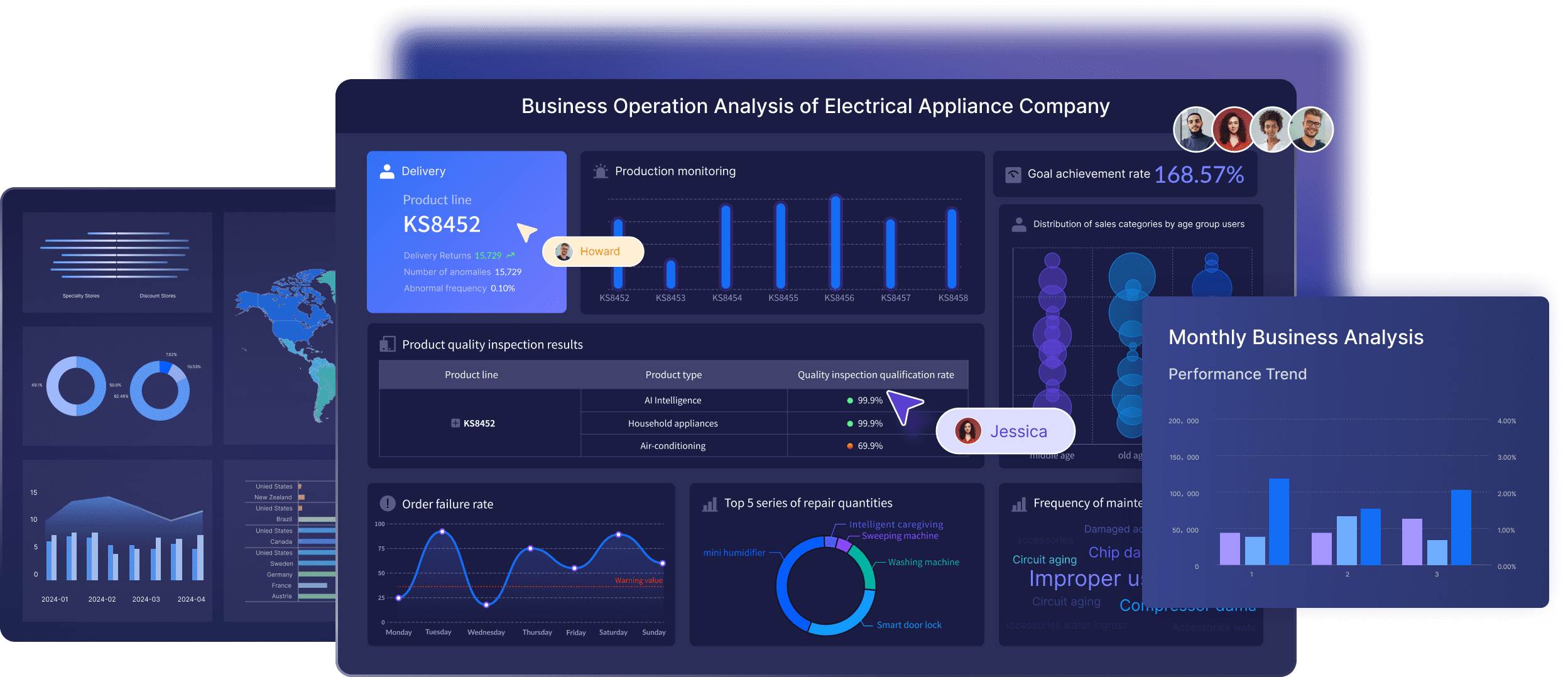
Key Benefits of Data Integration
Data integration offers several advantages that can transform how you manage information. First, it improves data quality by ensuring consistency and accuracy across all systems. This is crucial for making reliable business decisions. Second, it enhances efficiency by automating data pipelines, reducing manual effort, and saving time. With automated data pipelines, you can focus on strategic tasks rather than repetitive processes.
Another benefit is better data management. By centralizing your data, you can easily access and analyze information from a single platform. This is especially useful for businesses handling large volumes of data. Additionally, cloud data integration allows you to manage data across on-premise and cloud environments seamlessly. This flexibility supports scalability and ensures your systems can grow with your business.
Additionally, utilizing FineReport enhances data management by allowing organizations to generate comprehensive reports, facilitating deeper analysis and insights. This is especially beneficial for adhering to regulatory compliance and performance monitoring.
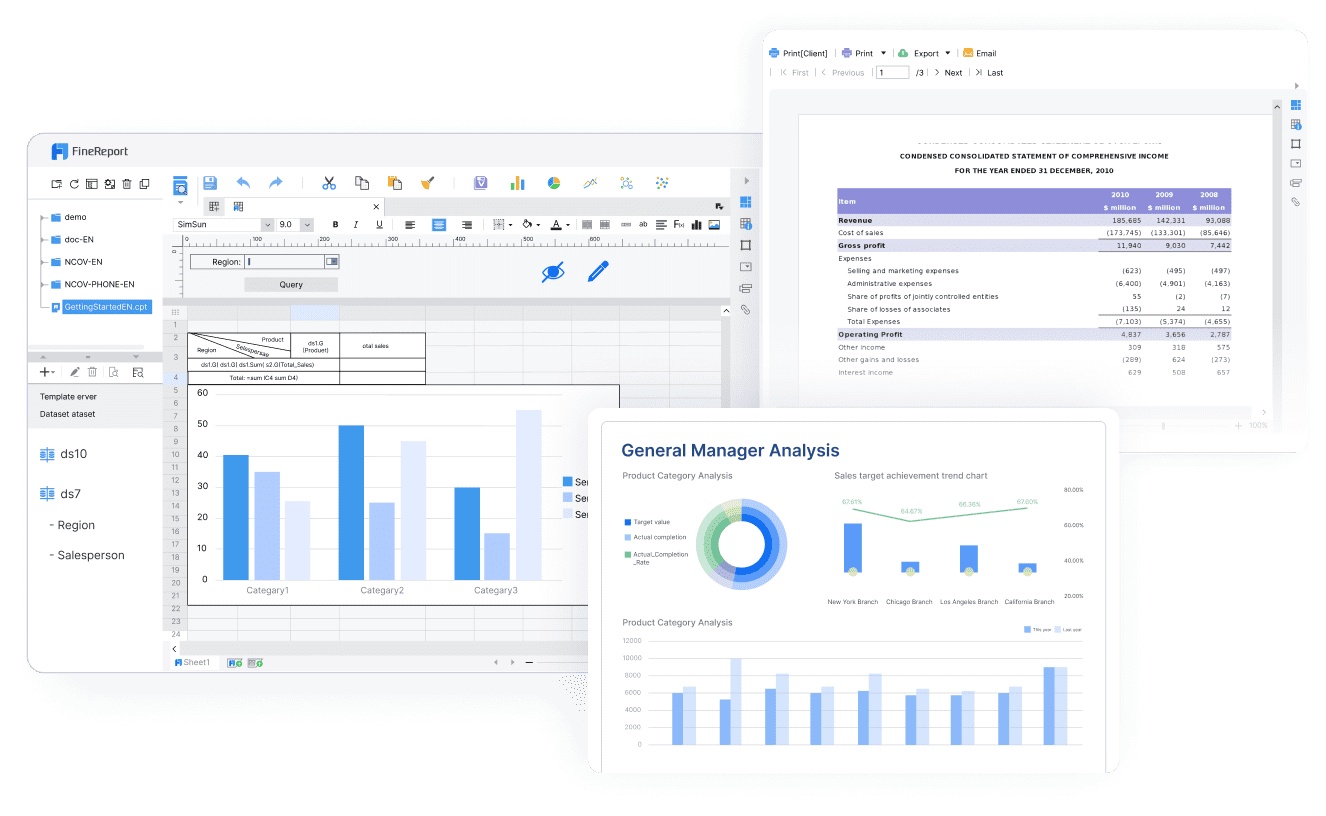
The trend towards real-time data integration is accentuated by the increasing adoption of Internet of Things (IoT) devices, which feed continuous data streams into analytical models for immediate insights. It enables you to process and analyze data as it is generated, providing up-to-date insights. This is particularly valuable for industries like finance and e-commerce, where timely information is critical. By leveraging the best data integration tools, you can unlock these benefits and create a more agile, data-driven organization.
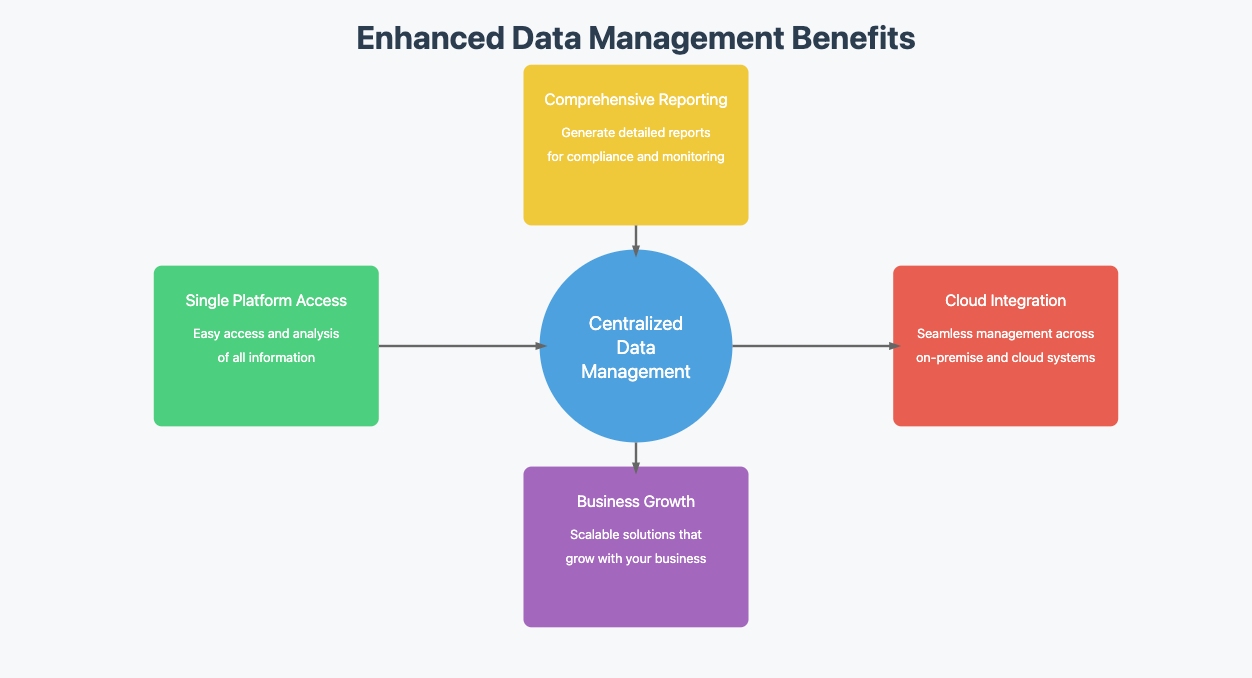
Types of Data Integration Vendors
Cloud-Based Tools
Modern cloud-based data integration tools have evolved to include serverless computing features, allowing businesses to scale data integration processes dynamically without managing the underlying infrastructure. Cloud-based data integration tools like FineVis offer robust data visualization capabilities hosted on remote servers, enhancing accessibility and scalability for businesses prioritizing flexibility. These tools are ideal for businesses that prioritize flexibility and scalability. They allow you to manage data integration across multiple locations without needing physical infrastructure. Cloud-based ETL tools simplify the data integration process by automating tasks like extraction, transformation, and loading. This reduces manual effort and improves data quality.
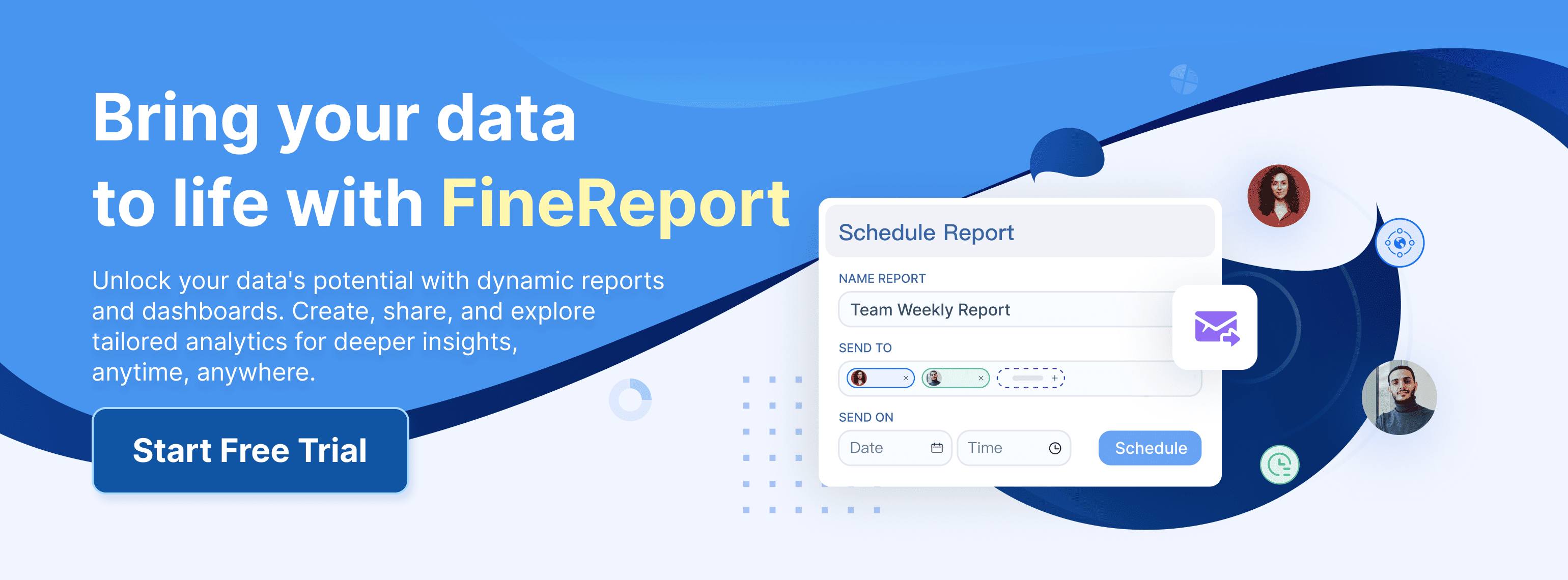
One major advantage of cloud-based ETL tools is their cost structure. You pay only for the resources you use, making them budget-friendly for small and medium-sized businesses. However, costs can increase as you add more features or connectors. These tools also offer excellent mobility, enabling you to access data from anywhere. Despite these benefits, security remains a concern. Since your data is stored on third-party servers, you must ensure compliance with privacy regulations.
On-Premise Tools
On-premise data integration tools operate within your organization’s infrastructure. These tools give you complete control over your data, making them a preferred choice for businesses handling sensitive information. On-premise ETL tools excel in security and customization. You can tailor them to meet specific business needs, ensuring better data management.
Unlike cloud-based ETL tools, on-premise solutions require a significant upfront investment. However, they do not have recurring costs for additional features. These tools also offer faster processing since they do not rely on internet connectivity. A key limitation is their lack of mobility. While remote access is possible, it often requires third-party connectors.
Here’s a comparison of cloud-based and on-premise data integration tools:
| Feature | On-Premise | Cloud |
|---|---|---|
| Cost | Paid once upfront, no additional costs for new features. | Pay for resources used, but costs increase with additional features and connectors. |
| Control | Complete control over security and customization; faster processing. | Ownership of data is questionable; dependent on third-party for data access. |
| Security | Preferred for sensitive data; higher privacy and security. | Major concern; vulnerable to breaches and must comply with privacy laws. |
| Mobility | Can be accessed remotely but may need third-party connectors. | Offers more mobility and flexibility; easier mobile access but with greater security risks. |
| Compliance | Easier to maintain compliance as data is kept in-house. | Difficult to achieve compliance; reliant on service provider's adherence to regulations. |
Open-Source Tools
Open-source data integration tools are freely available and maintained by a community of developers. These tools are highly customizable, allowing you to adapt them to your specific requirements. Open-source ETL tools are cost-efficient, making them an excellent choice for startups or businesses with limited budgets.
The flexibility of open-source ETL tools enables you to create unique workflows. Community support ensures continuous improvements and updates. However, these tools come with challenges. Setting them up requires technical expertise, and the learning curve can be steep. Unlike proprietary data integration tools, open-source solutions may lack dedicated customer support.
Here’s a comparison of open-source and proprietary data integration tools:
| Type | Advantages | Disadvantages |
|---|---|---|
| Open-Source Tools | 1. Cost-Efficiency: Typically free to use. | 1. Complex Setup: Requires more effort and expertise for setup. |
| 2. Community Support: Continuous improvements from a user community. | 2. Limited Support: Community support may not match proprietary vendors. | |
| 3. Flexibility: Customizable to suit specific needs. | 3. Steeper Learning Curve: Requires additional training for users. | |
| Proprietary Tools | 1. Ease of Use: User-friendly interfaces and pre-built connectors. | 1. Costly Licensing: Significant expense due to licensing fees. |
| 2. Vendor Support: Dedicated customer support for troubleshooting. | 2. Vendor Lock-In: Dependence on a single vendor's ecosystem. | |
| 3. Scalability: Designed to handle large data volumes. | 3. Limited Customization: Restrictions on customizing workflows. |
Open-source data integration tools are ideal if you value flexibility and cost savings. However, you must weigh these benefits against the potential challenges of setup and support.
Hybrid Solutions
Recent developments in hybrid data integration solutions now focus on enhancing data security and regulatory compliance, integrating cutting-edge encryption methods and compliance monitoring tools into their offerings. Hybrid solutions, supported by FanRuan’s suite of products, merge the scalability of cloud services with the robust security of on-premise solutions, optimizing resource allocation and enhancing data handling efficiency. These solutions allow you to leverage the scalability of the cloud while maintaining the control and security of on-premise environments. They are ideal for businesses that need flexibility to manage diverse data sources and workflows.
One of the key advantages of hybrid solutions is their ability to optimize resource utilization. You can allocate computing resources based on specific needs, balancing the performance of on-premise systems with the scalability of the cloud. This ensures efficient use of your infrastructure. Hybrid systems also enhance security and compliance. They protect sensitive information through encryption and access controls, helping you meet data privacy regulations.

Hybrid solutions improve business agility. Their flexibility allows you to adapt quickly to changing conditions, making your operations more competitive. Cost management is another benefit. By combining on-premise and cloud environments, you can scale resources as needed and avoid the risks of fluctuating cloud pricing. These systems also empower non-specialist users with self-service capabilities. This democratizes data handling, enabling faster integration processes.
The future-proof nature of hybrid solutions ensures they remain relevant as technology evolves. You can easily integrate new tools and platforms, protecting your investment in data integration. Here’s a breakdown of the unique features of hybrid solutions:
| Feature | Description |
|---|---|
| Resource Utilization | Hybrid solutions optimize computing resources by allowing data engineers to allocate them based on specific needs, balancing cloud scalability with on-premises performance. |
| Security and Compliance | These systems help organizations comply with data privacy regulations and enhance security through encryption and access controls, ensuring sensitive information is protected. |
| Business Agility | The flexibility of hybrid integration allows organizations to adapt quickly to changing conditions, enhancing competitiveness and operational efficiency. |
| Cost Management | By leveraging both on-premises and cloud environments, organizations can optimize costs, scaling resources as needed and mitigating risks associated with fluctuating cloud pricing. |
| Self-Service Capabilities | Empowering non-specialist users to manage integration tasks directly speeds up processes and enhances business agility, democratizing data handling. |
| Future-Proof Nature | Hybrid systems allow for easy integration of new tools and platforms, protecting technology investments and ensuring adaptability to innovations and industry standards. |
Hybrid solutions are particularly effective for businesses with complex data integration needs. They provide the flexibility and scalability required to handle diverse data sources. By using hybrid ETL tools, you can streamline workflows and ensure your data integration processes remain efficient and secure.
2025’s Top 20 Data Integration Vendors
To help you navigate the diverse offerings in the market, we've compiled a detailed comparison of the top 20 data integration vendors, focusing on their unique features, pricing structures, and performance metrics. This comparison aims to provide clear insights that assist in making informed decisions tailored to your specific business needs.
Vendor 1: AWS Glue
Key Features
AWS Glue is a fully managed ETL service designed to simplify data integration. It automates tasks like schema discovery, code generation, and job scheduling. The tool supports serverless architecture, which eliminates the need for infrastructure management. It integrates seamlessly with other AWS services, such as Amazon S3 and Redshift, to streamline workflows. Additionally, AWS Glue offers a visual interface for creating and managing ETL jobs, making it user-friendly.
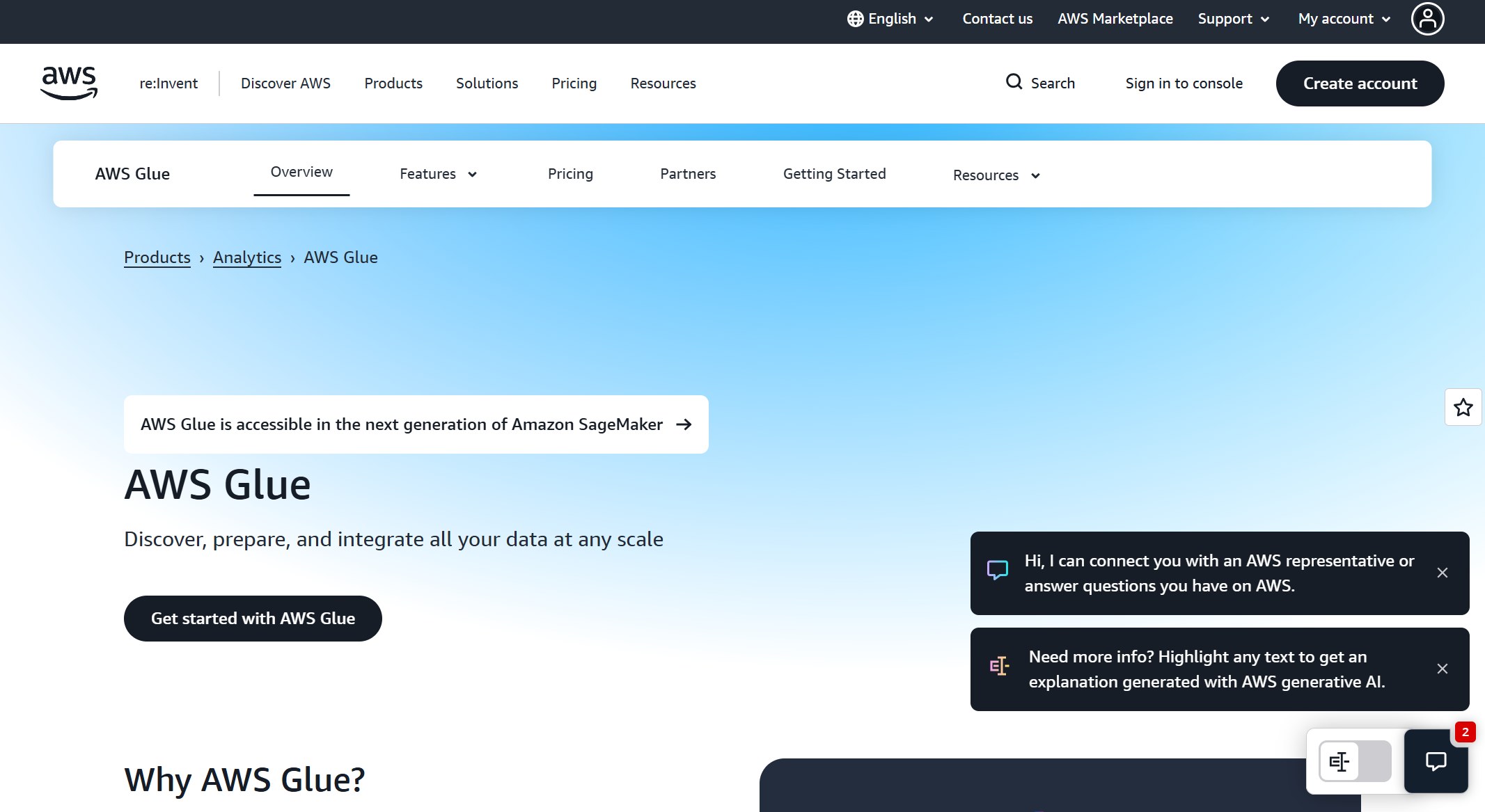
Benefits
AWS Glue reduces the complexity of managing ETL tools by automating repetitive tasks. Its serverless nature ensures scalability, allowing you to handle large datasets without worrying about infrastructure. The tool’s integration with AWS services enhances efficiency, especially for businesses already using the AWS ecosystem. Its visual interface simplifies the learning curve, making it accessible even for non-technical users.
When compared to other vendors such as Informatica PowerCenter and Microsoft SQL Server, AWS Glue stands out for its serverless architecture which significantly reduces the operational overhead, offering a cost-effective solution for businesses scaling large datasets.
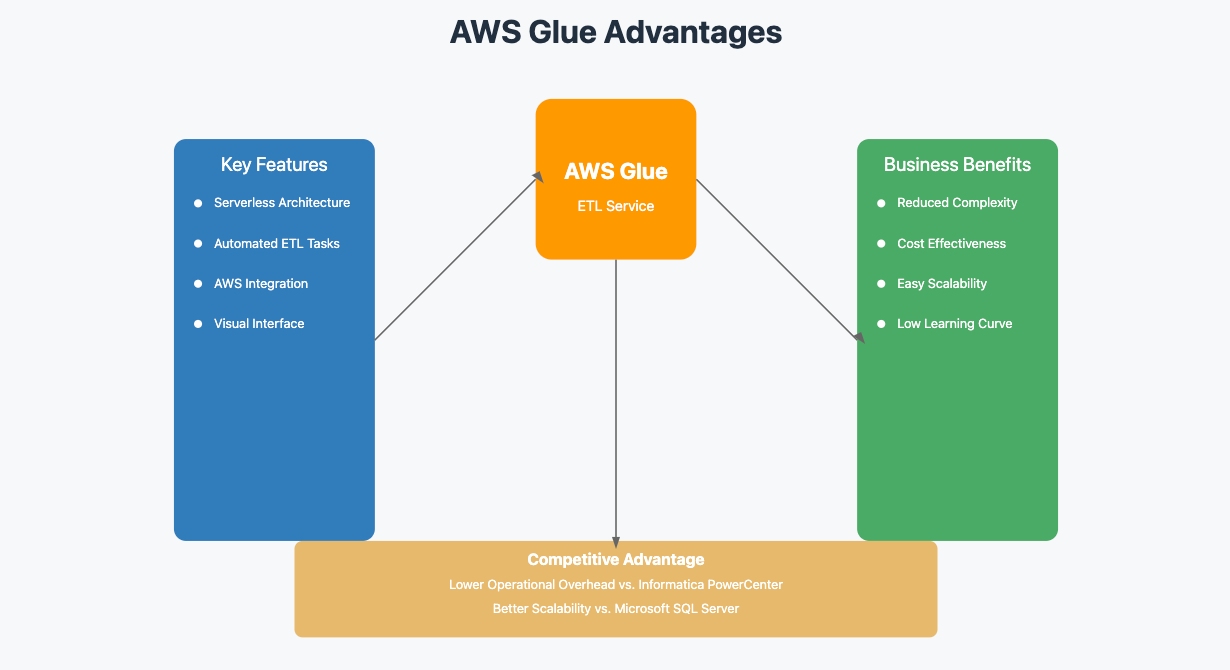
Ideal Use Cases
AWS Glue is ideal for businesses that rely heavily on AWS services. It works well for processing large-scale data pipelines and creating data lakes. The tool is also suitable for organizations seeking to automate ETL processes while minimizing infrastructure management.
Vendor 2: Informatica PowerCenter
Key Features
Informatica PowerCenter is a robust data integration platform known for its versatility. It supports a wide range of data sources, including on-premises and cloud systems. The tool excels in ETL processes, offering advanced features like metadata management and data quality monitoring. It also provides strong security measures, ensuring compliance with industry standards.
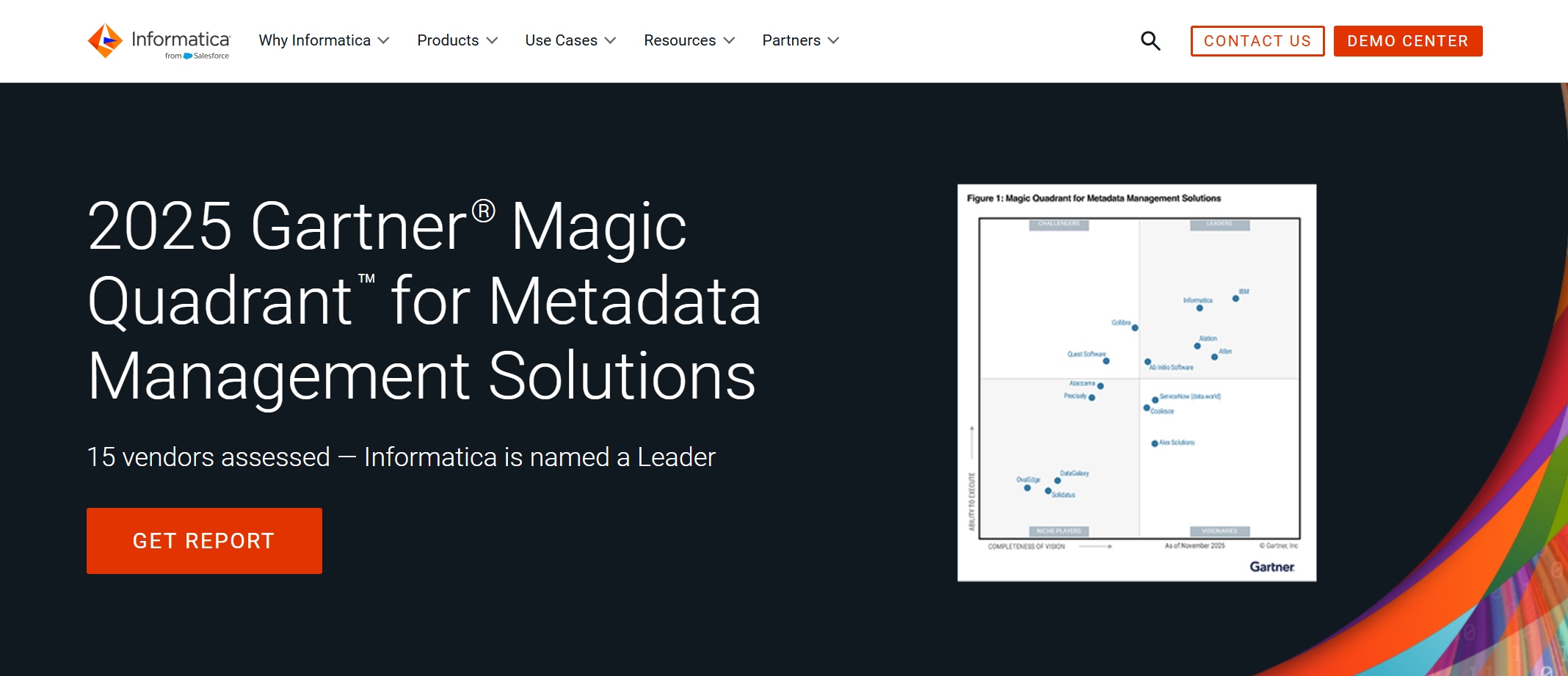
Benefits
Informatica PowerCenter enhances data integration by supporting complex workflows. Its metadata-driven approach improves data governance and traceability. The platform’s scalability makes it suitable for businesses of all sizes. Additionally, its strong security features protect sensitive information, making it a reliable choice for industries like healthcare and finance.
Informatica PowerCenter stands out for its robust data governance and comprehensive integration capabilities, making it a stronger choice for large enterprises than solutions like Microsoft SQL Server, which are better suited for environments already leveraging Microsoft products.
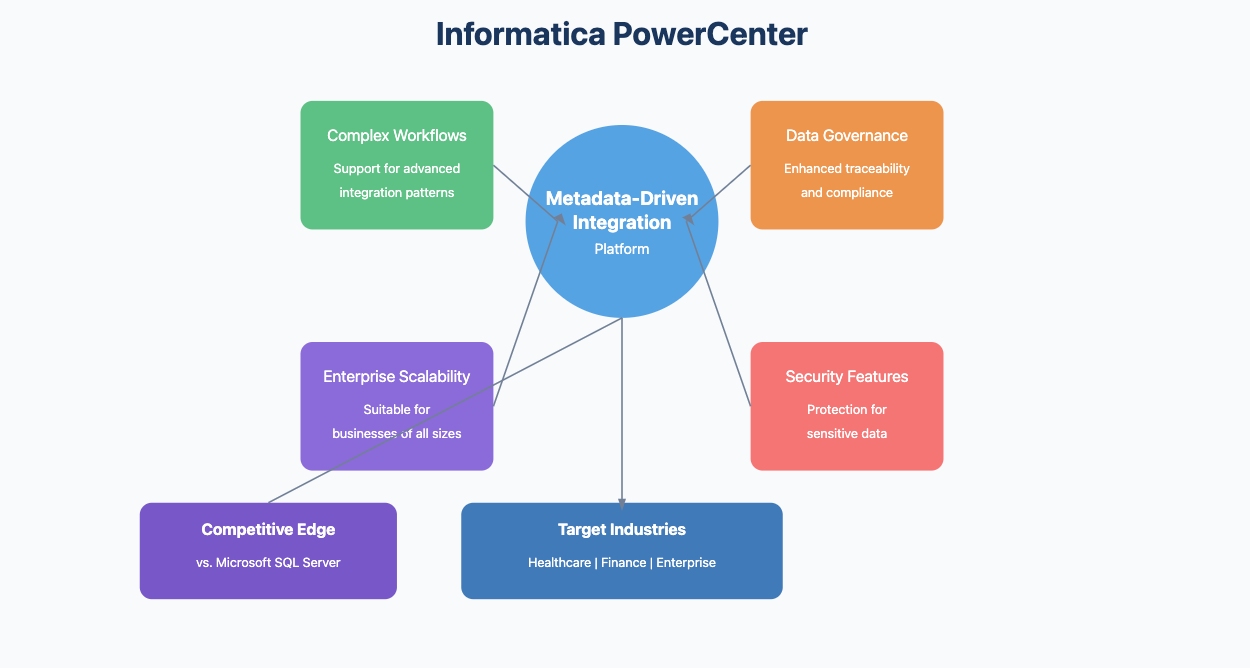
Ideal Use Cases
Informatica PowerCenter is widely used for on-premises data integration. It is particularly effective for integrating systems like Electronic Medical Records (EMR) and feeding data into data warehouses like Teradata. The tool is also suitable for processing semi-structured and unstructured data, such as web and mobile logs.
Vendor 3: Microsoft SQL Server
Key Features
Microsoft SQL Server offers a comprehensive suite of tools for data integration and management. Its ETL capabilities are powered by SQL Server Integration Services (SSIS), which supports data extraction, transformation, and loading. The platform includes built-in analytics and reporting features, enabling real-time insights. It also integrates seamlessly with Microsoft’s ecosystem, including Azure and Power BI.
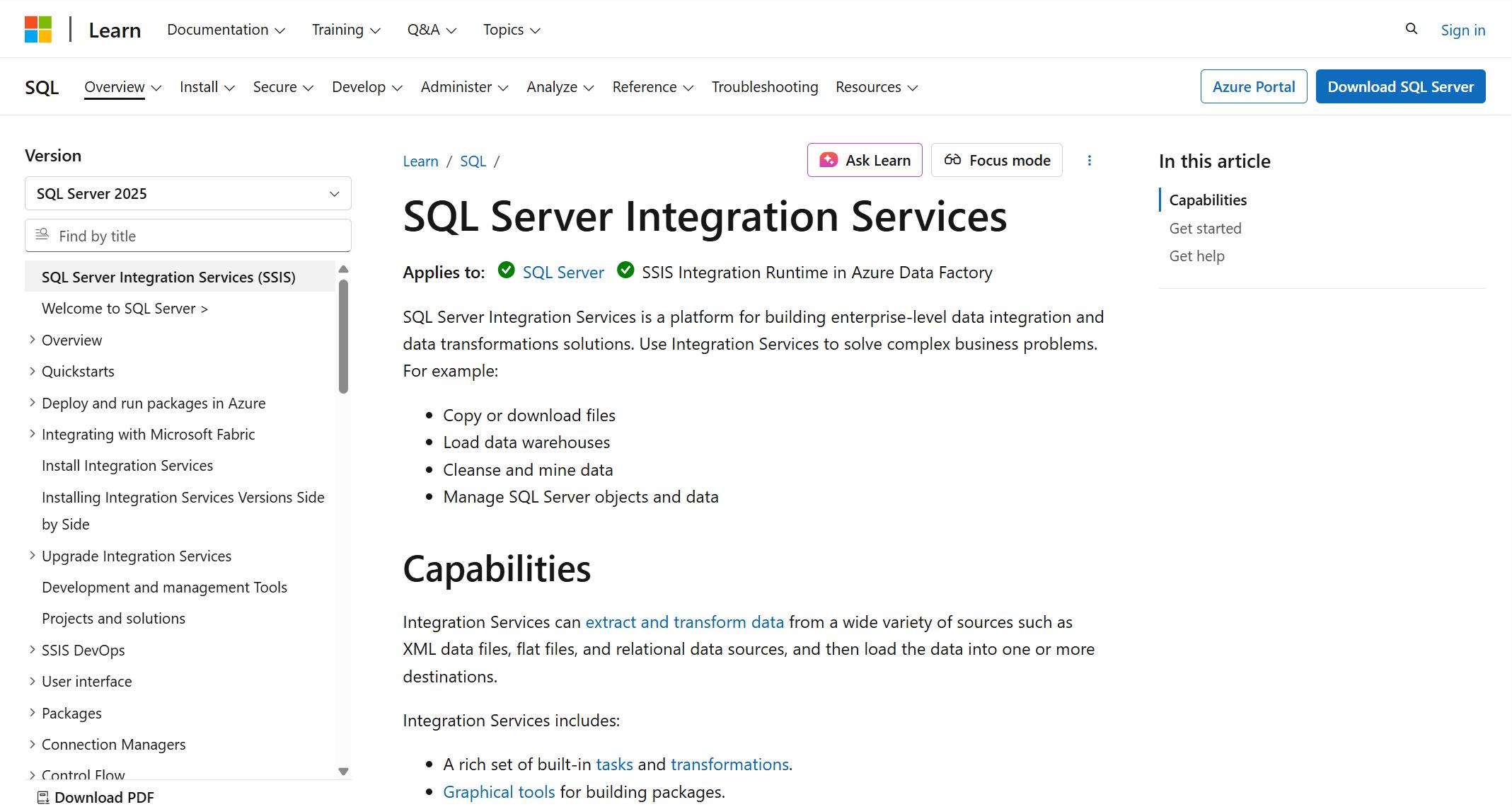
Benefits
Microsoft SQL Server simplifies data integration by providing a unified platform for ETL, analytics, and reporting. Its integration with other Microsoft tools enhances productivity, especially for businesses already using the Microsoft ecosystem. The platform’s scalability and robust performance make it suitable for handling large datasets.
While Microsoft SQL Server offers seamless integration within the Microsoft ecosystem and real-time analytics, it may not provide the same level of scalability and flexibility in handling diverse data environments as cloud-native solutions like Google Cloud Dataflow.
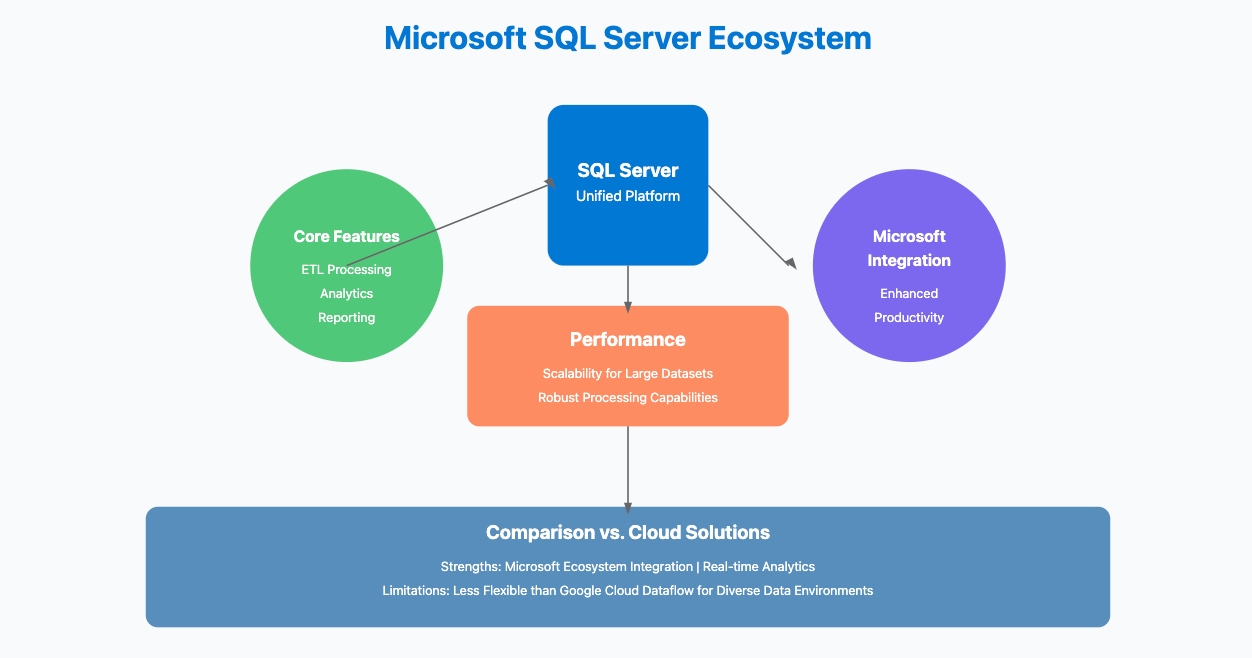
Ideal Use Cases
Microsoft SQL Server is ideal for businesses seeking an all-in-one solution for data integration and analytics. It works well for organizations using Microsoft tools like Azure and Power BI. The platform is also suitable for real-time data processing and reporting.
Vendor 4: FME by Safe Software
Key Features
FME by Safe Software specializes in spatial data integration, making it a standout choice for industries like GIS and urban planning. It supports over 450 data formats, ensuring compatibility with diverse systems. The platform offers a drag-and-drop interface, enabling you to design workflows without coding. FME also excels in real-time data processing, allowing you to handle dynamic datasets efficiently. Its automation capabilities reduce manual intervention, streamlining your data integration processes.
Benefits
FME simplifies complex data workflows by providing a user-friendly interface. Its support for numerous data formats ensures seamless integration across systems. The platform’s real-time processing capabilities enable you to work with live data, which is crucial for time-sensitive projects. Automation features save time and reduce errors, enhancing overall efficiency. FME’s focus on spatial data makes it an excellent choice for organizations managing geospatial information.
FME excels in spatial data integration, making it the go-to choice for GIS professionals, unlike generalist tools like Fivetran, which focus on broader data integration needs without specialized spatial capabilities.
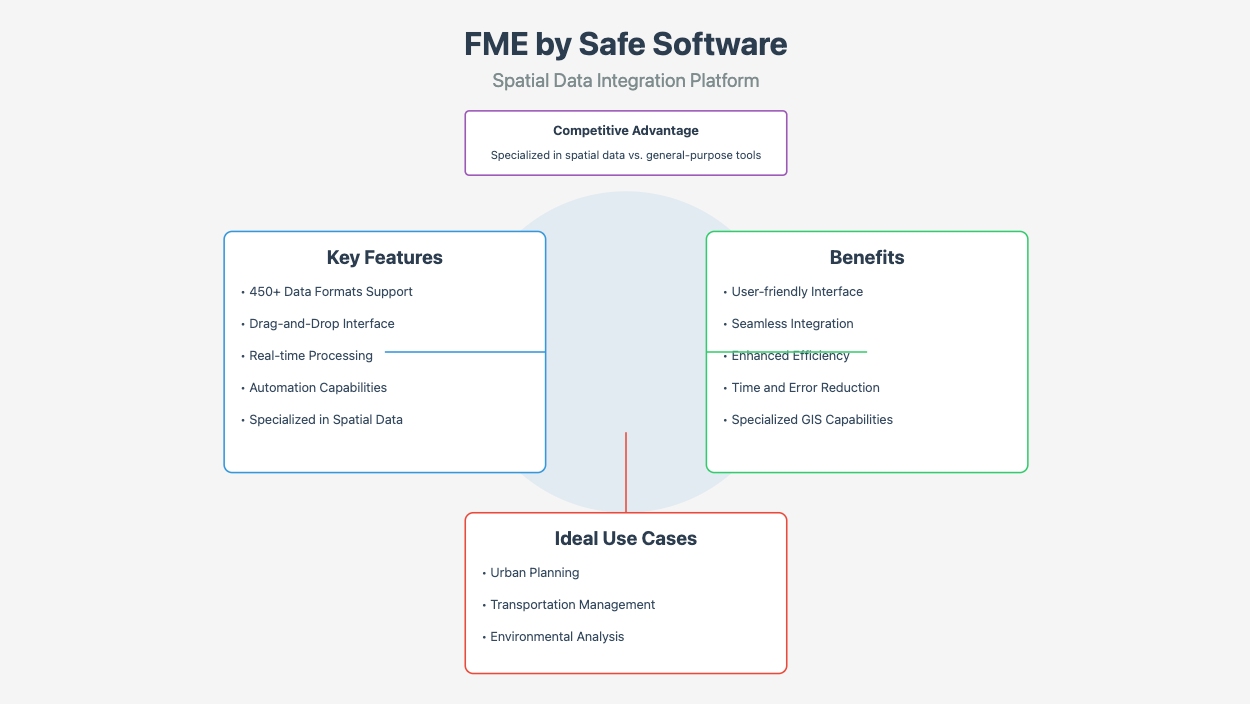
Ideal Use Cases
FME is ideal for industries that rely on spatial data, such as urban planning, transportation, and environmental management. It works well for integrating GIS data with other enterprise systems. The platform is also suitable for automating repetitive tasks in data workflows, freeing up resources for strategic initiatives.
Vendor 5: Fivetran
Key Features
Fivetran simplifies data integration by offering a fully managed service. It provides over 150 pre-built connectors for databases and data warehouses, making it easy to set up. The platform uses a pricing model based on monthly active rows, which helps you manage costs effectively. However, Fivetran lacks proprietary transformation capabilities, requiring additional tools for complete ETL workflows.
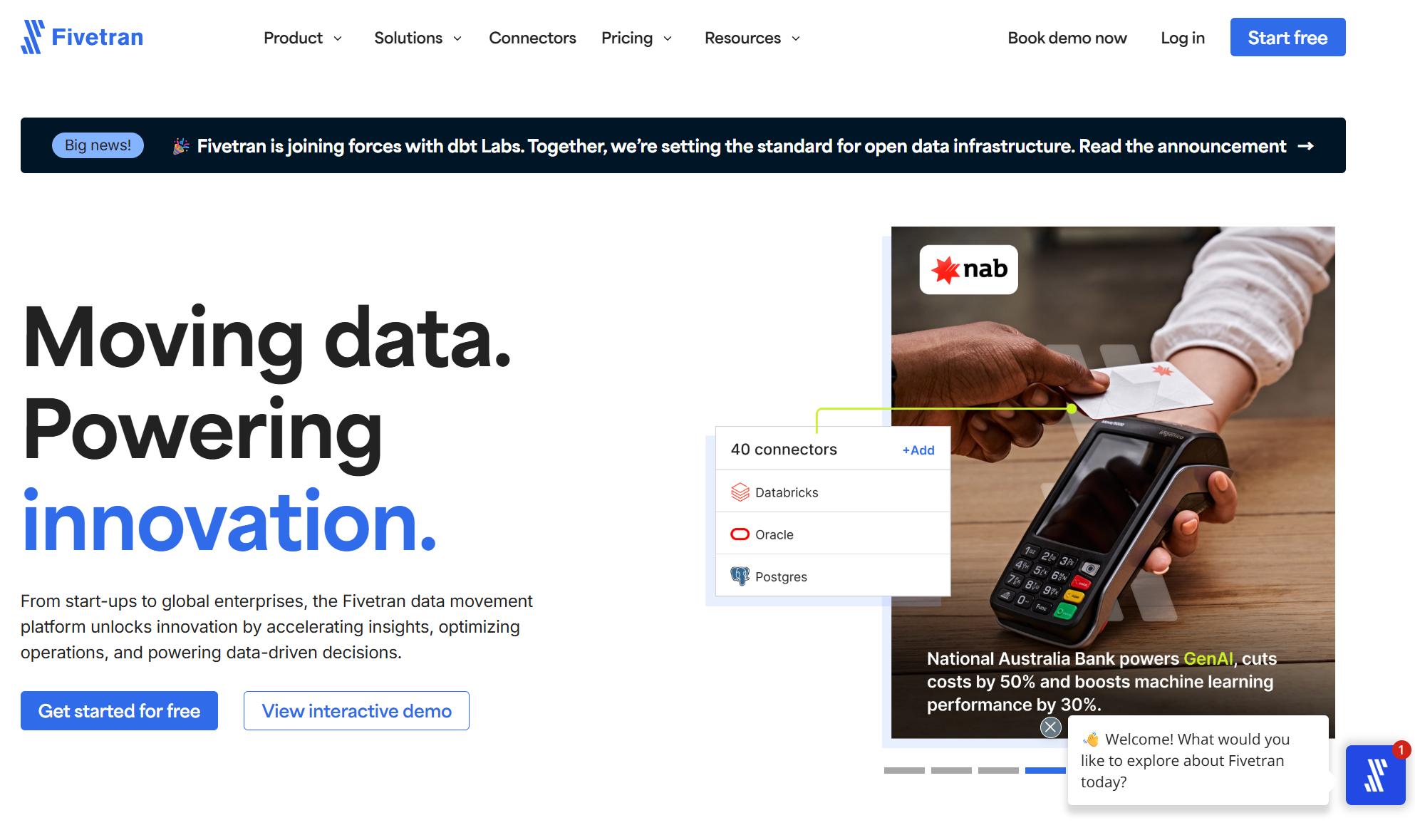
Benefits
Fivetran’s ease of connection makes it accessible even for non-technical users. Its pre-built connectors save time and effort, allowing you to focus on analysis rather than setup. The pricing model offers transparency, helping you budget more effectively. While it lacks built-in transformation features, its compatibility with other ETL tools ensures flexibility.
Fivetran simplifies setup with extensive pre-built connectors, appealing to businesses with less technical expertise, compared to more complex platforms like Talend, which offer deeper customization but require more setup time.
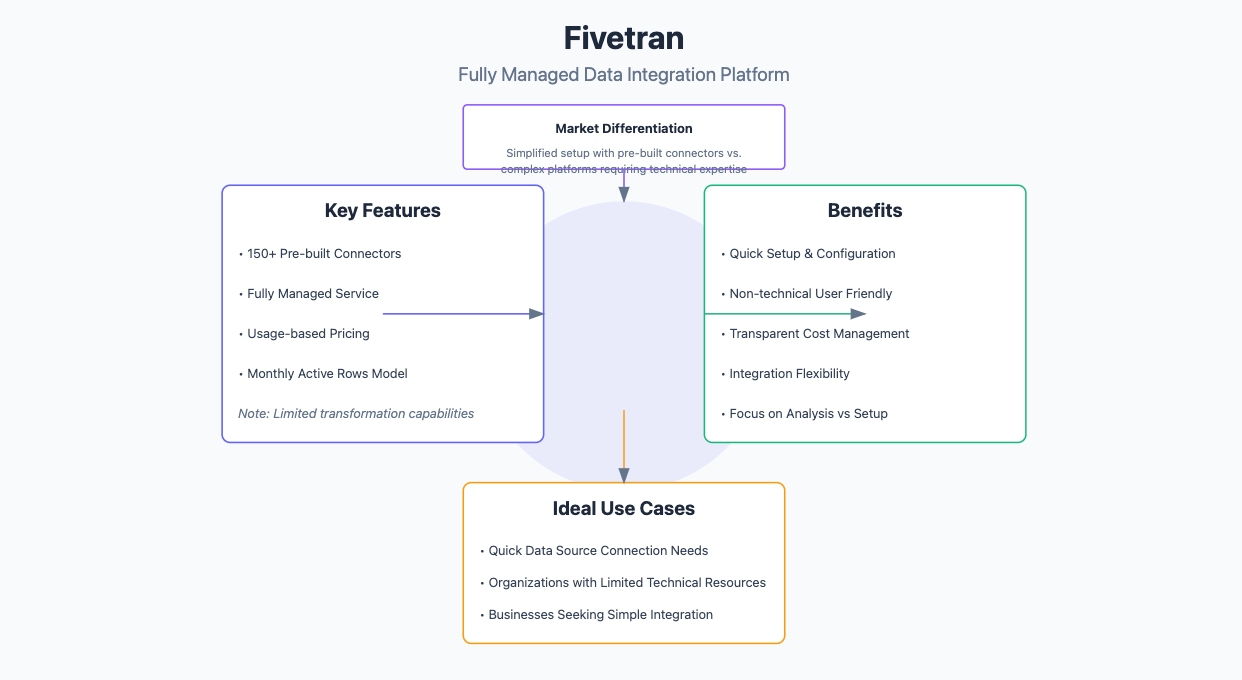
Ideal Use Cases
Fivetran is perfect for businesses seeking a straightforward data integration solution. It works well for organizations that need to connect multiple data sources quickly. The platform is particularly useful for companies with limited technical expertise, as its user-friendly design minimizes the learning curve.
Vendor 6: Denodo Platform
Key Features
The Denodo Platform focuses on data virtualization, enabling you to access and integrate data without moving it. It supports real-time data integration, providing up-to-date insights. The platform includes advanced security features, ensuring compliance with data privacy regulations. Its scalability allows you to manage increasing data demands effectively.
Benefits
Denodo’s data virtualization capabilities reduce the need for data replication, saving storage costs. Real-time integration ensures you always have access to the latest information. The platform’s scalability supports your business as it grows, adapting to evolving data needs. Its robust security features protect sensitive information, making it a reliable choice for industries like finance and healthcare.
Denodo's data virtualization technology provides real-time data access and integration, offering a unique approach compared to traditional ETL-based tools like Oracle Data Integrator, which physically move and process data.
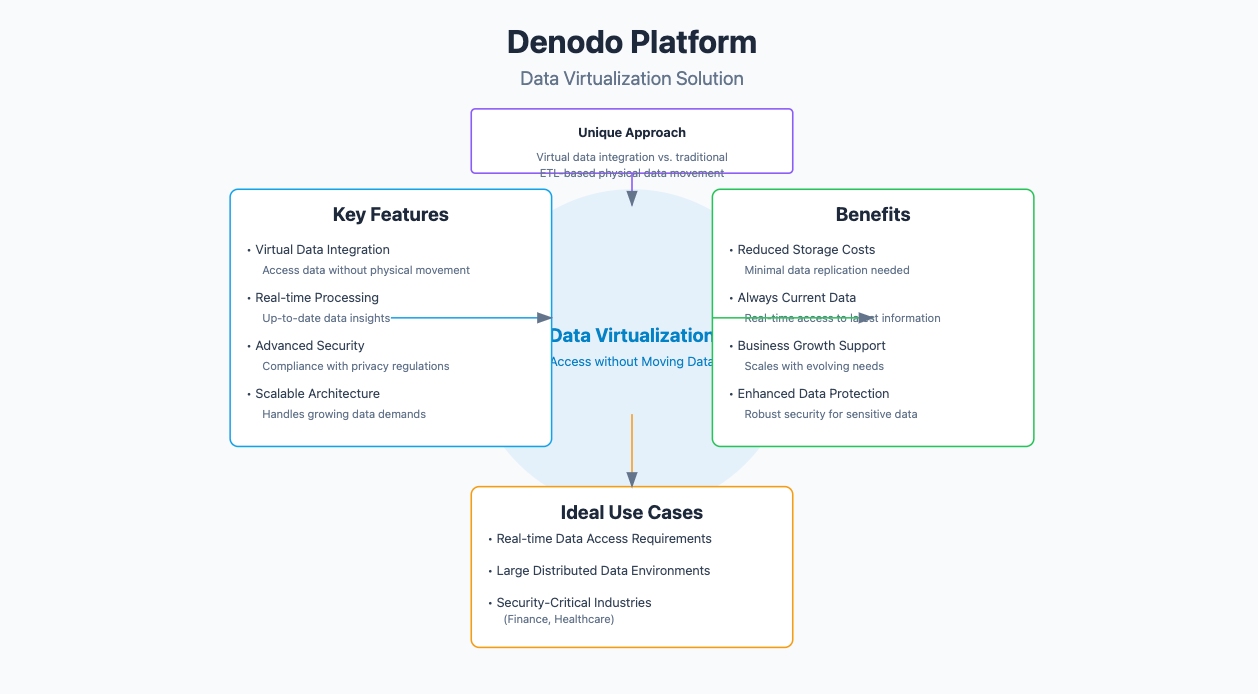
Ideal Use Cases
Denodo is ideal for organizations that need real-time access to data without the overhead of replication. It works well for businesses managing large, distributed datasets. The platform is also suitable for companies prioritizing security and compliance in their data integration processes.
Vendor 7: Ab Initio
Key Features
Ab Initio stands out for its ability to handle complex data integration workflows. Its graphical user interface (GUI) allows you to create workflows without extensive coding. The platform uses parallel processing to execute tasks faster and optimize hardware resources. It scales efficiently to accommodate growing data volumes, making it suitable for businesses of all sizes. Ab Initio integrates seamlessly with various databases, file systems, and cloud platforms. Additionally, its robust metadata management simplifies data lineage tracking and version control.
| Feature | Description |
|---|---|
| Graphical User Interface | Intuitive GUI for creating data workflows without extensive coding. |
| Parallel Processing | Ensures faster execution of tasks and optimal hardware resource utilization. |
| Scalability | Adapts to increasing data volumes, suitable for businesses of all sizes. |
| Integration Capabilities | Seamlessly integrates with various databases, file systems, and cloud. |
| Robust Metadata Management | Simplifies data lineage tracking and version control for better governance. |
Benefits
Ab Initio simplifies complex workflows, saving you time and effort. Its parallel processing ensures faster execution, which improves efficiency. The platform’s scalability supports your business as it grows, adapting to increasing data demands. Its seamless integration capabilities reduce compatibility issues, enabling smoother workflows. Metadata management enhances governance, making it easier to track and manage your data.
Ab Initio is renowned for handling complex, high-volume data integration tasks more efficiently than tools like SnapLogic, thanks to its high-performance processing capabilities.
Ideal Use Cases
Ab Initio is ideal for businesses managing large-scale data integration projects. It works well for industries requiring high-performance ETL tools, such as finance and telecommunications. The platform is also suitable for organizations prioritizing data governance and compliance.
Vendor 8: Matillion ETL
Key Features
Matillion ETL is a cloud-native platform designed for modern data integration needs. It offers pre-built connectors for popular cloud data warehouses like Snowflake, Redshift, and BigQuery. The platform uses a pay-per-credit pricing model, making it cost-effective for businesses of all sizes. Matillion ETL provides a user-friendly interface, enabling you to design workflows without coding. Its scalability ensures it can handle increasing data volumes efficiently.
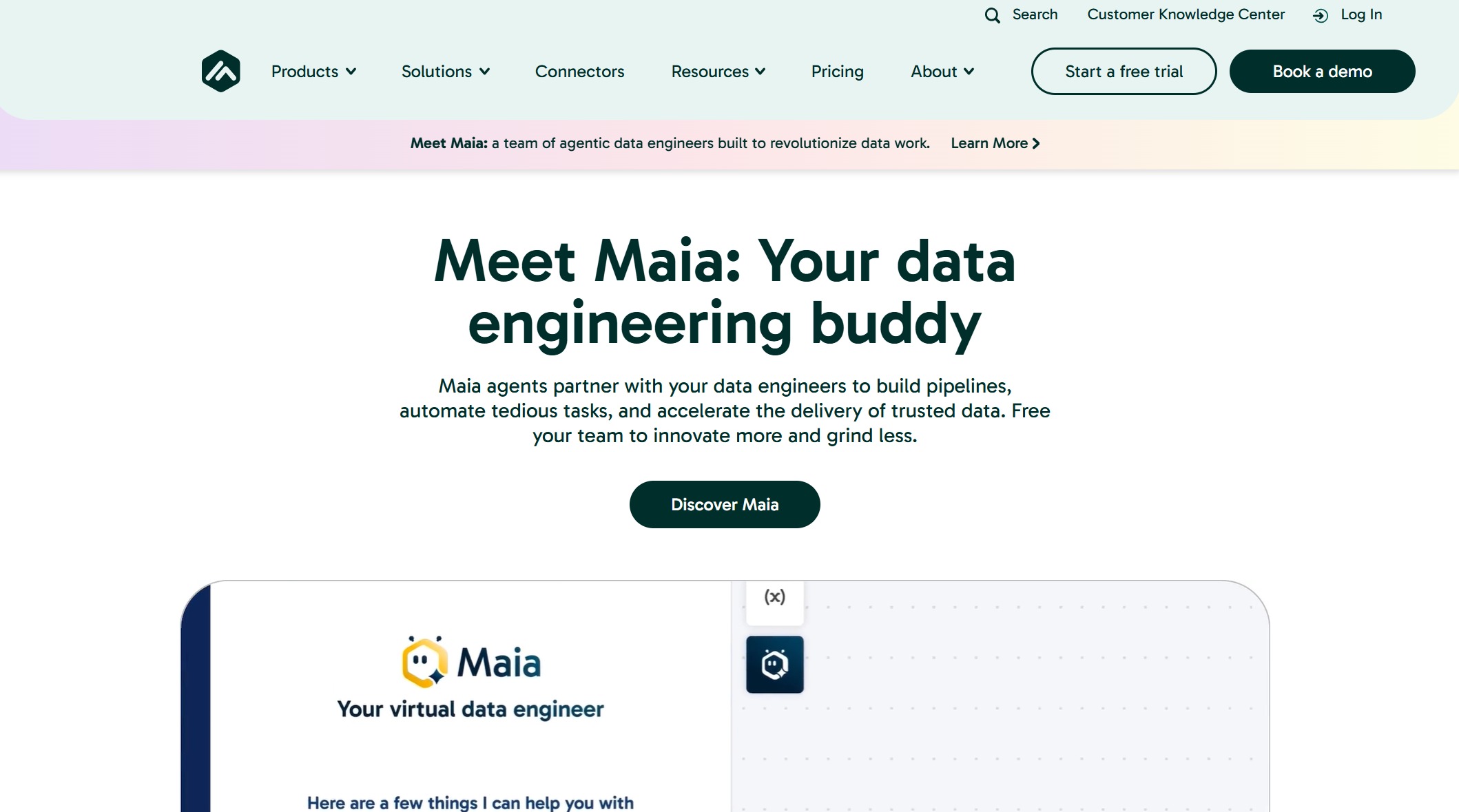
Benefits
Matillion ETL simplifies data integration by automating repetitive tasks. Its pre-built connectors save you time, allowing you to focus on analysis. The platform’s pricing model offers flexibility, helping you manage costs effectively. Its scalability ensures it can grow with your business, adapting to evolving data needs. The user-friendly interface reduces the learning curve, making it accessible even for non-technical users.
- Basic plan: $2 per credit
- Advanced plan: $2.50 per credit
- Enterprise plan: $2.70 per credit
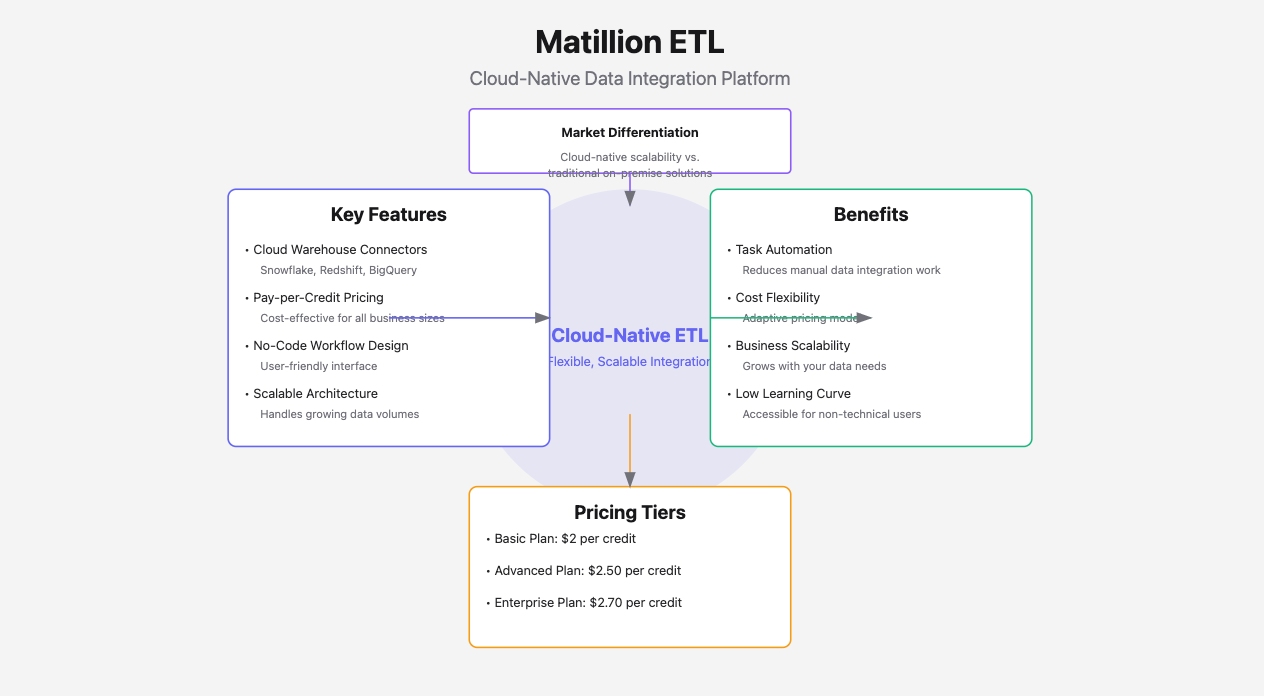
Matillion ETL shines with its cloud-native approach and scalability, making it a preferred option for dynamic cloud environments over on-premise solutions like IBM InfoSphere DataStage.
Ideal Use Cases
Matillion ETL is perfect for businesses using cloud data warehouses. It works well for organizations seeking cost-effective ETL tools with scalable capabilities. The platform is also suitable for teams with limited technical expertise, as its intuitive design simplifies workflow creation.
Vendor 9: Airbyte
Key Features
Airbyte is an open-source data integration platform that appeals to developers. Its transparency allows you to view and trust the software’s code. The platform offers flexibility, enabling you to customize workflows to meet your specific needs. It eliminates licensing fees, making it cost-effective. Airbyte benefits from a large community of developers who provide support and enhancements. It integrates seamlessly with cloud platforms, ensuring efficient data handling.
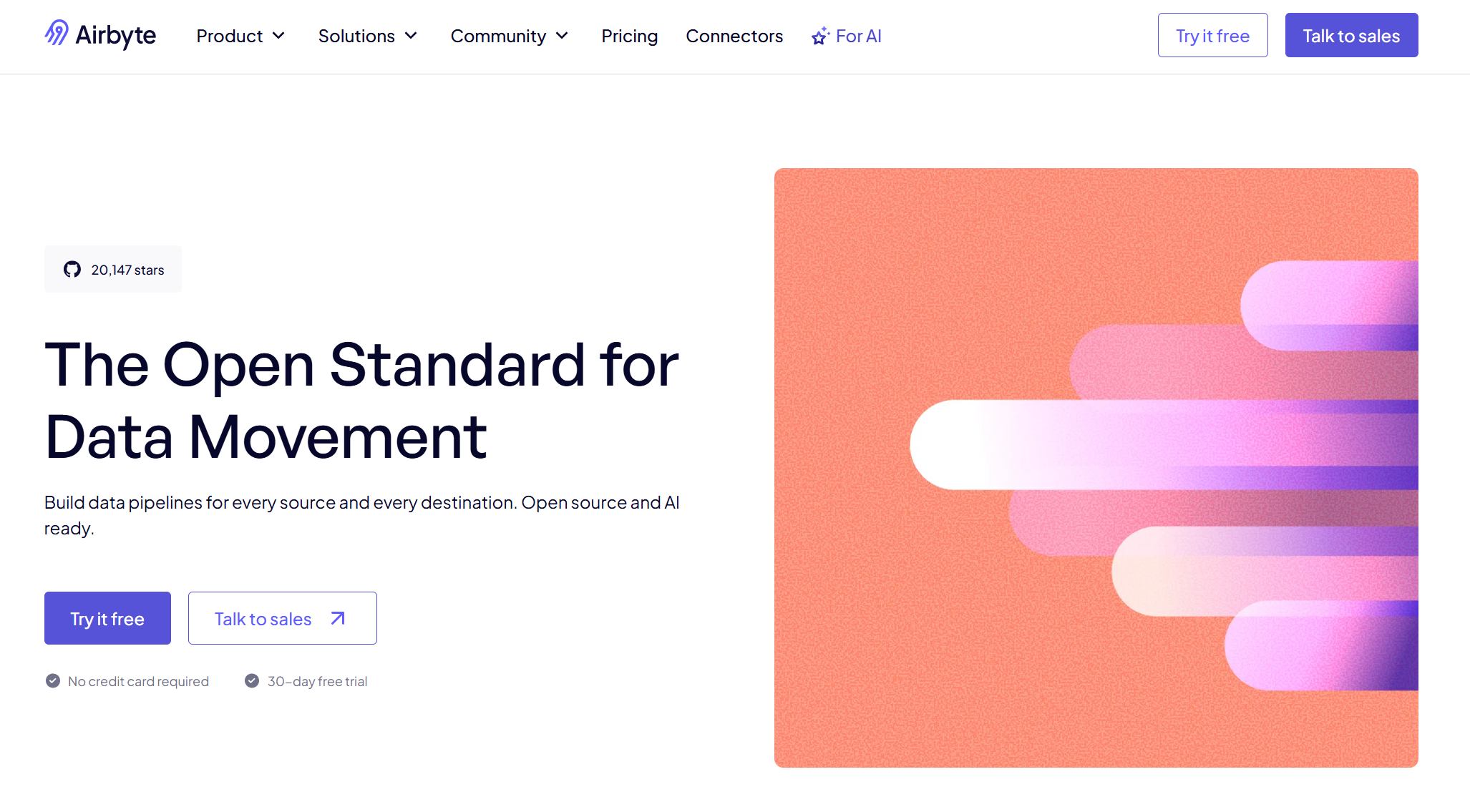
| Feature | Description |
|---|---|
| Transparency and Trust | Users can see the software’s code, fostering trust as there are no hidden functionalities or proprietary clauses. |
| Flexibility and Customization | Users can modify and build upon the existing code to tailor their data integration process to their specific needs. |
| Cost-Effective | Users can avoid licensing fees and optimize costs through scalable cloud pricing models. |
| Community Support | A large, active community helps address challenges collectively, leading to faster resolutions and enhancements. |
| Seamless Cloud Integration | Deploying open-source elements in cloud platforms ensures efficient data integration and leverages the features of cloud providers. |
Benefits
Airbyte’s open-source nature gives you full control over your data integration processes. Its flexibility allows you to customize workflows, ensuring they meet your unique requirements. The platform’s cost-effectiveness makes it an excellent choice for businesses with limited budgets. Community support ensures you can resolve challenges quickly. Its seamless cloud integration enhances efficiency, enabling you to leverage cloud features effectively.
Airbyte offers flexibility and cost-effectiveness with its open-source model, providing a strong alternative to proprietary tools like Informatica, which may involve higher licensing costs.
Ideal Use Cases
Airbyte is ideal for developers and businesses seeking customizable ETL tools. It works well for organizations prioritizing cost savings and flexibility. The platform is also suitable for teams looking to integrate open-source solutions with cloud environments.
Vendor 10: Talend
Key Features
Talend offers a comprehensive suite of ETL tools designed to simplify data integration. Its open-source platform provides flexibility and scalability for businesses of all sizes. Talend includes over 1,000 pre-built connectors, enabling seamless integration with various data sources. The platform supports real-time data processing, ensuring you always have access to the latest information. Talend also emphasizes data quality, offering features like data profiling and cleansing to enhance accuracy. Its cloud-native architecture ensures compatibility with modern data environments.

Benefits
Talend’s user-friendly interface makes it accessible even for non-technical users. Its pre-built connectors save time by streamlining the integration process. The platform’s focus on data quality ensures you can trust the insights derived from your data. Real-time processing capabilities allow you to make timely decisions, which is crucial in fast-paced industries. Talend’s scalability ensures it can grow with your business, adapting to increasing data demands.
Talend's comprehensive integration suite offers greater flexibility and scalability compared to specialized tools like FME, making it suitable for businesses needing robust data integration across various data sources.

Ideal Use Cases
Talend is ideal for businesses seeking a versatile data integration solution. It works well for organizations managing complex ETL workflows across multiple data sources. The platform is particularly effective for industries like retail and healthcare, where data quality and real-time insights are critical.
Vendor 11: Hevo Data
Key Features
Hevo Data simplifies data integration with its fully managed ETL tools. The platform automates data pipelines, reducing manual effort and improving efficiency. Hevo Data supports over 150 integrations, including cloud data warehouses, SaaS applications, and databases. Its real-time data replication ensures you always have up-to-date information. The platform also includes features like schema management and error handling to enhance reliability.
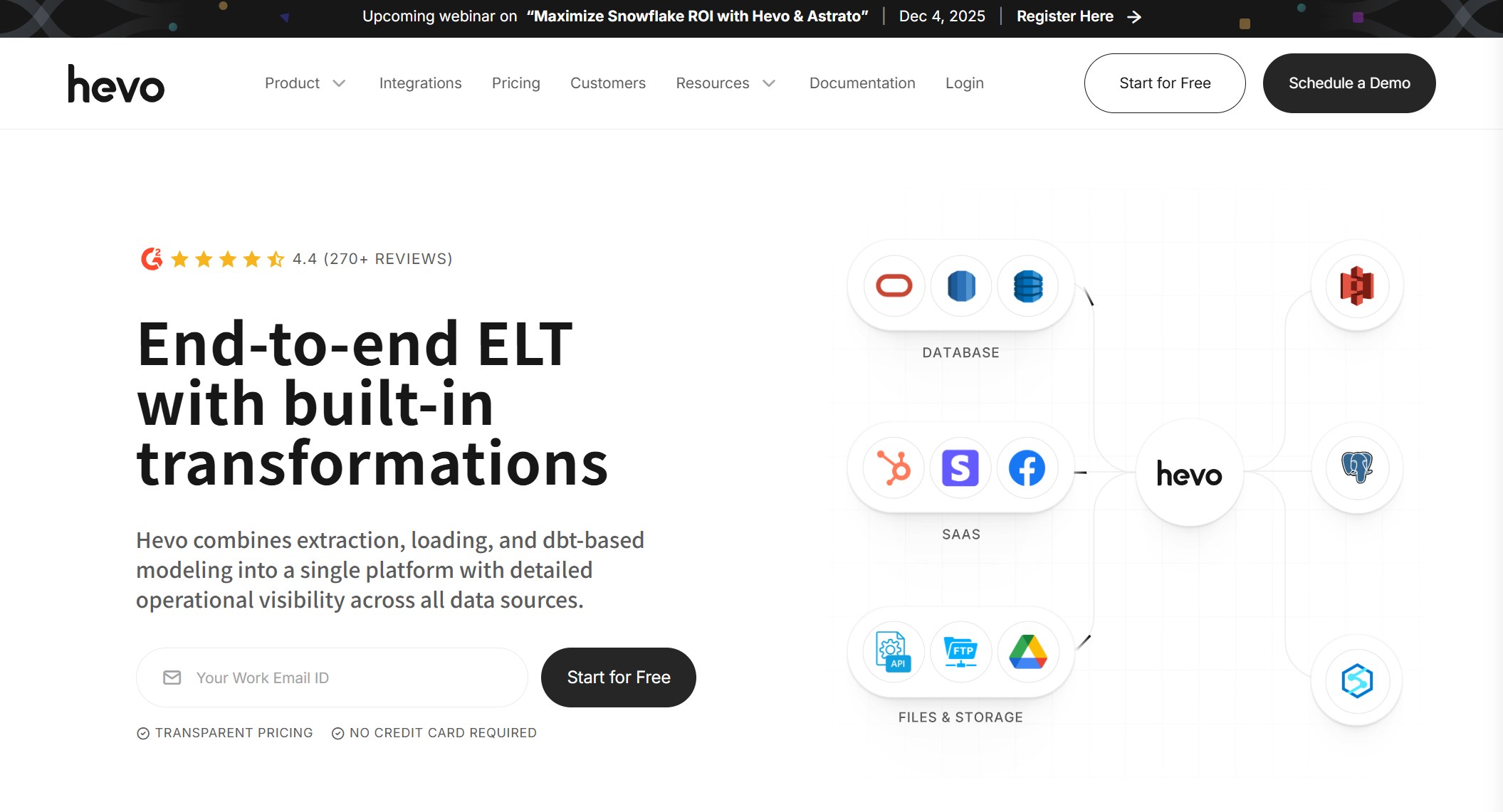
| Integration Type | Examples |
|---|---|
| Cloud Data Warehouses | Snowflake, Redshift, Azure Synapse Analytics |
| SaaS Applications | Google Analytics, Salesforce, HubSpot |
| Databases | MongoDB, BigQuery, Pipedrive |
| Data Lakes | Various options available |
Benefits
Hevo Data’s automation features save time and reduce errors, allowing you to focus on analysis. Its wide range of integrations ensures compatibility with your existing systems. Real-time replication provides timely insights, which is essential for decision-making. The platform’s user-friendly design minimizes the learning curve, making it accessible to teams with limited technical expertise.
Ideal Use Cases
Hevo Data is perfect for businesses seeking a hassle-free data integration solution. It works well for organizations that need to connect multiple data sources quickly. The platform is particularly useful for startups and small businesses due to its cost-effectiveness and ease of use.
Vendor 12: Flowgear
Key Features
Flowgear combines powerful ETL tools with automation features to enhance data integration processes. Its no-code capabilities make it accessible to non-technical users. The platform offers over 200 pre-built connectors and workflow templates, simplifying setup. Flowgear’s visual data mapping tool allows you to design complex integrations without coding. It also integrates iPaaS and RPA, providing a comprehensive solution for modern businesses.
| Feature | Description |
|---|---|
| No-code capabilities | Flowgear allows users to implement integrations without any coding, making it accessible to non-technical users. |
| Pre-built connectors | Offers over 200 pre-built connectors and workflow templates to streamline integration processes. |
| Visual data mapping | The QuickMap visual data mapper simplifies the creation of complex integrations without coding. |
| iPaaS & RPA integration | Combines Integration Platform as a Service (iPaaS) with Robotic Process Automation (RPA) for comprehensive solutions. |
| Agile API management | Enables building, managing, and integrating APIs from a single interface, enhancing efficiency. |
| Workflow representation | Integrations are designed as workflows, providing a visual representation of tasks for better clarity. |
Benefits
Flowgear’s no-code capabilities empower your team to manage integrations without technical expertise. Its pre-built connectors save time, allowing you to focus on strategic tasks. The platform’s visual data mapping tool simplifies complex workflows, enhancing efficiency. By combining iPaaS and RPA, Flowgear provides a versatile solution for diverse integration needs. Its agile API management streamlines processes, improving overall productivity.
Ideal Use Cases
Flowgear is ideal for businesses seeking a user-friendly data integration platform. It works well for organizations with limited technical resources. The platform is particularly effective for automating repetitive tasks and managing APIs, making it a valuable tool for industries like logistics and e-commerce.
Vendor 13: Microsoft Azure Data Factory
Key Features
Microsoft Azure Data Factory is a cloud-based platform designed to simplify data integration. It supports a wide range of data sources, enabling you to connect, transform, and load data efficiently. The platform offers a code-free interface, making it accessible to users with limited technical expertise. It also integrates seamlessly with other Azure services, such as Azure Synapse Analytics and Power BI, to enhance your workflows. Additionally, Azure Data Factory provides robust monitoring tools, allowing you to track pipeline performance and troubleshoot issues in real time.

Benefits
Azure Data Factory offers several advantages for large-scale data integration:
- Scalable: It handles large workloads efficiently, ensuring smooth operations as your data grows.
- Continuous Integration and Deployment: GitHub integration simplifies development and deployment processes.
- Monitoring and Management: You can monitor pipeline performance and resolve issues quickly.
- Security and Compliance: Role-based access control and secure data transfer protect your sensitive information.
These features make Azure Data Factory a reliable choice for managing complex data workflows.
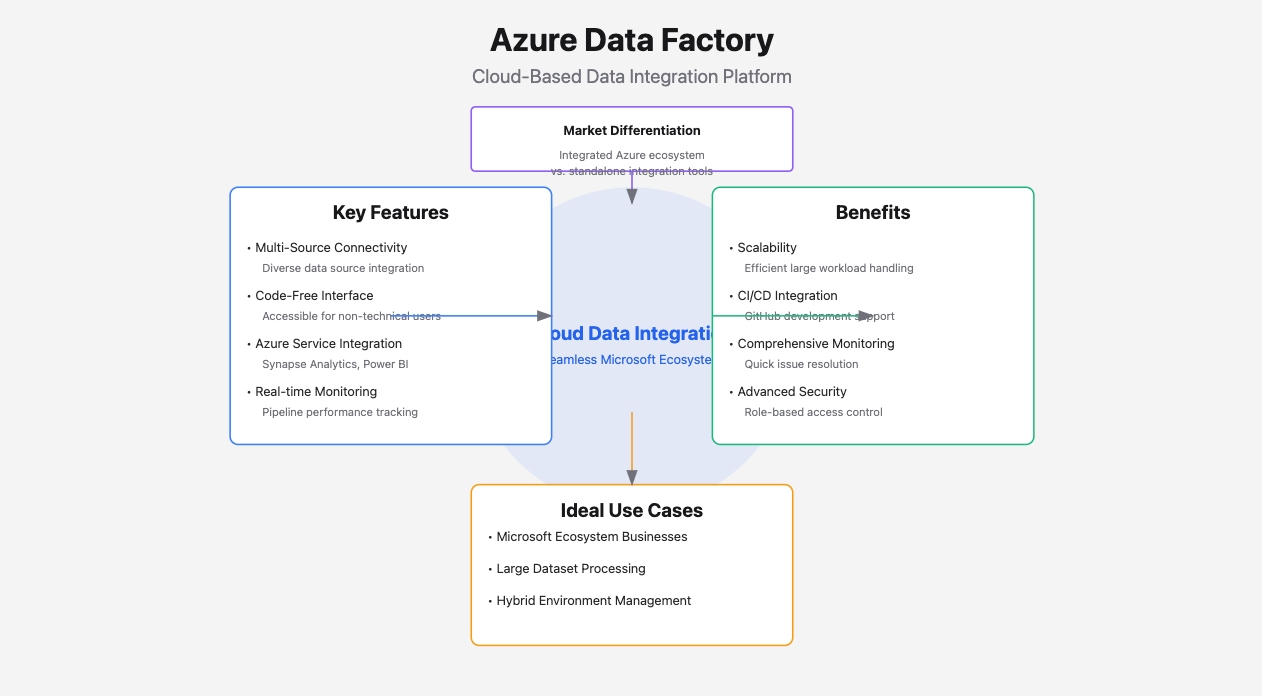
Ideal Use Cases
Azure Data Factory is ideal for businesses using the Microsoft ecosystem. It works well for organizations that need to process large datasets or manage hybrid environments. The platform is also suitable for teams seeking a scalable and secure solution for their data integration needs.
Vendor 14: Dell Boomi
Key Features
Dell Boomi is a cloud-native platform that combines powerful ETL tools with user-friendly features. Its drag-and-drop interface simplifies integration building, even for non-technical users. The platform includes a library of pre-built connectors for popular applications, reducing the need for custom coding. Visual workflows provide a clear representation of data flows, making it easier to manage and optimize your integrations.
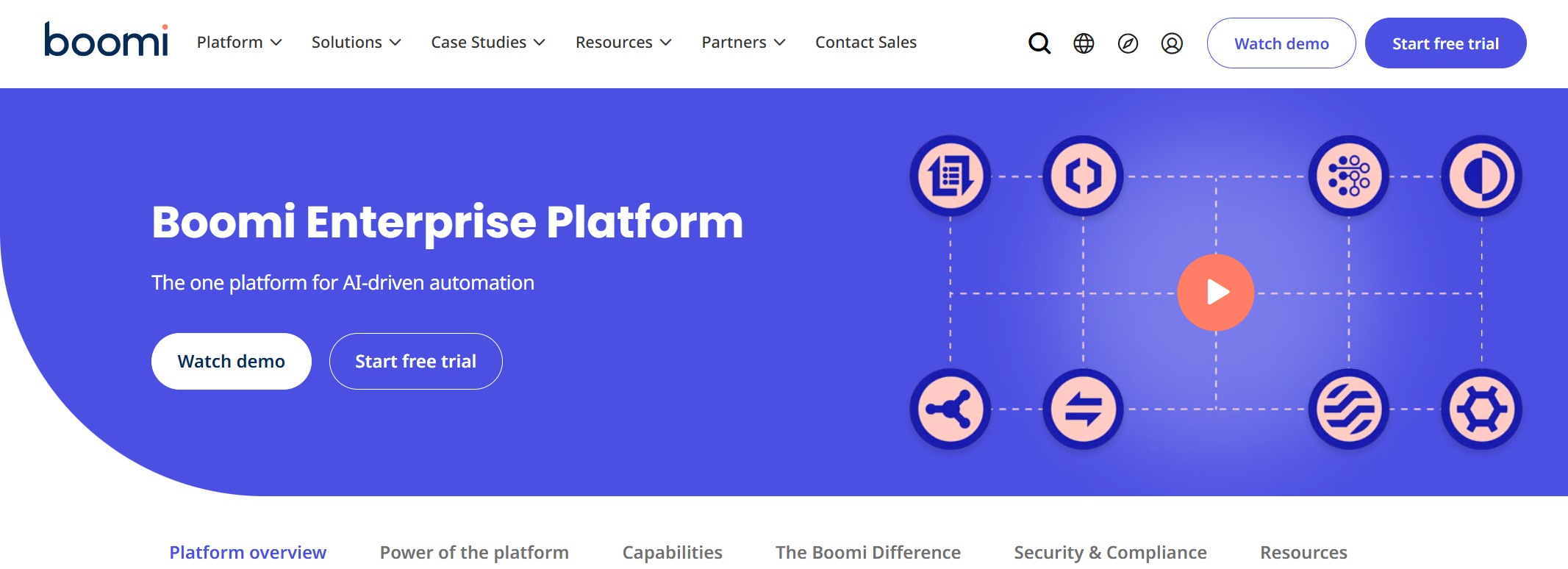
Benefits
Dell Boomi’s intuitive design makes it accessible to users of all skill levels. The pre-built connectors save time by streamlining the integration process. Visual workflows enhance understanding, allowing you to identify and resolve issues quickly. These features make Dell Boomi a versatile tool for businesses of all sizes.
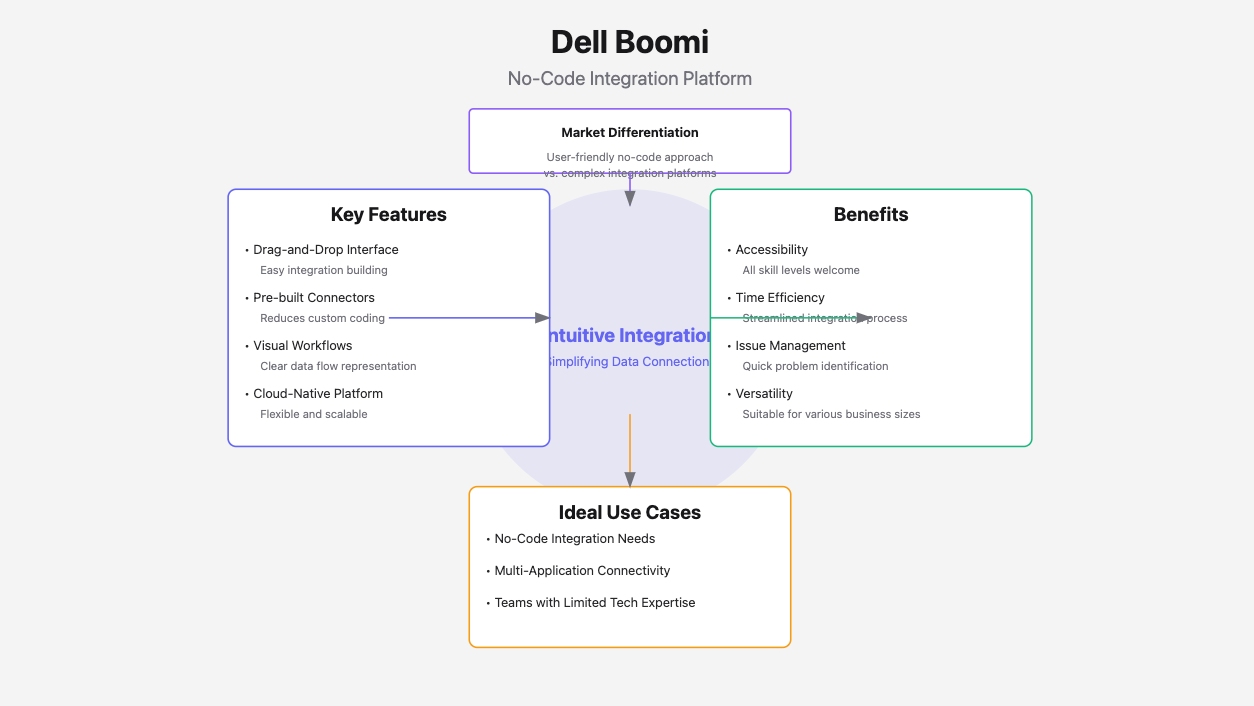
Ideal Use Cases
Dell Boomi is perfect for organizations seeking a no-code or low-code solution for data integration. It works well for businesses that need to connect multiple applications quickly. The platform is particularly effective for teams with limited technical expertise, as its user-friendly design minimizes the learning curve.
Vendor 15: SnapLogic
Key Features
SnapLogic leverages AI-driven capabilities to enhance data integration. Its SnapGPT feature simplifies workflows by generating SQL queries and transforming data using natural language. AutoSuggest provides smart recommendations based on historical patterns, improving data mapping. The platform also includes AgentCreator, which allows you to create and deploy AI agents without deep technical knowledge. These features make SnapLogic a powerful tool for modern ETL processes.
Benefits
SnapLogic’s AI-driven tools save time and reduce errors in your workflows. SnapGPT and AutoSuggest enhance productivity by automating repetitive tasks. AgentCreator promotes accessibility, enabling you to leverage AI without requiring advanced skills. These capabilities ensure efficient and accurate data integration, making SnapLogic a valuable asset for your business.
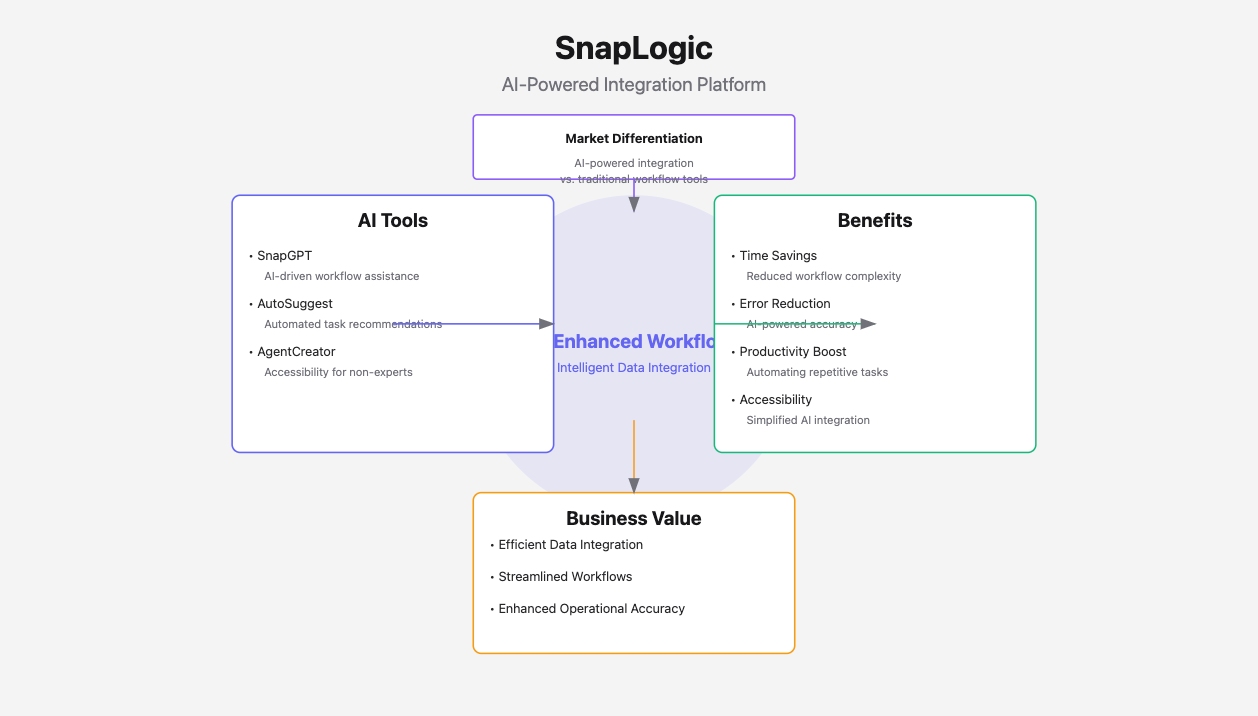
Ideal Use Cases
SnapLogic is ideal for organizations looking to incorporate AI into their data integration processes. It works well for businesses managing complex workflows or seeking to optimize data mapping. The platform is also suitable for teams aiming to improve efficiency through automation and AI-driven insights.
Vendor 16: IBM InfoSphere DataStage
Key Features
IBM InfoSphere DataStage offers enterprise-grade features that enhance your data integration processes. These include:
| Feature | Description |
|---|---|
| ELT Pushdown Express | Extract, load, and transform bulk data through SQL Pushdown. |
| Parallel engine and load balancing | Process data at scale with optimized ETL performance and maximize throughput. |
| Metadata support | Protect sensitive data with metadata exchange and data lineage for better governance. |
| Automated delivery pipelines | Automate CI/CD pipelines to reduce development costs. |
| Prebuilt connectors | Move data between multiple cloud sources and data warehouses like IBM Db2® Warehouse SaaS. |
| IBM DataStage Flow Designer | Use a machine learning-assisted interface to improve developer productivity. |
| In-flight data quality | Automatically resolve quality issues during data ingestion. |
| Automated failure detection | Reduce infrastructure management effort by up to 85%. |
| Distributed data processing | Execute cloud runtimes remotely while maintaining data sovereignty. |
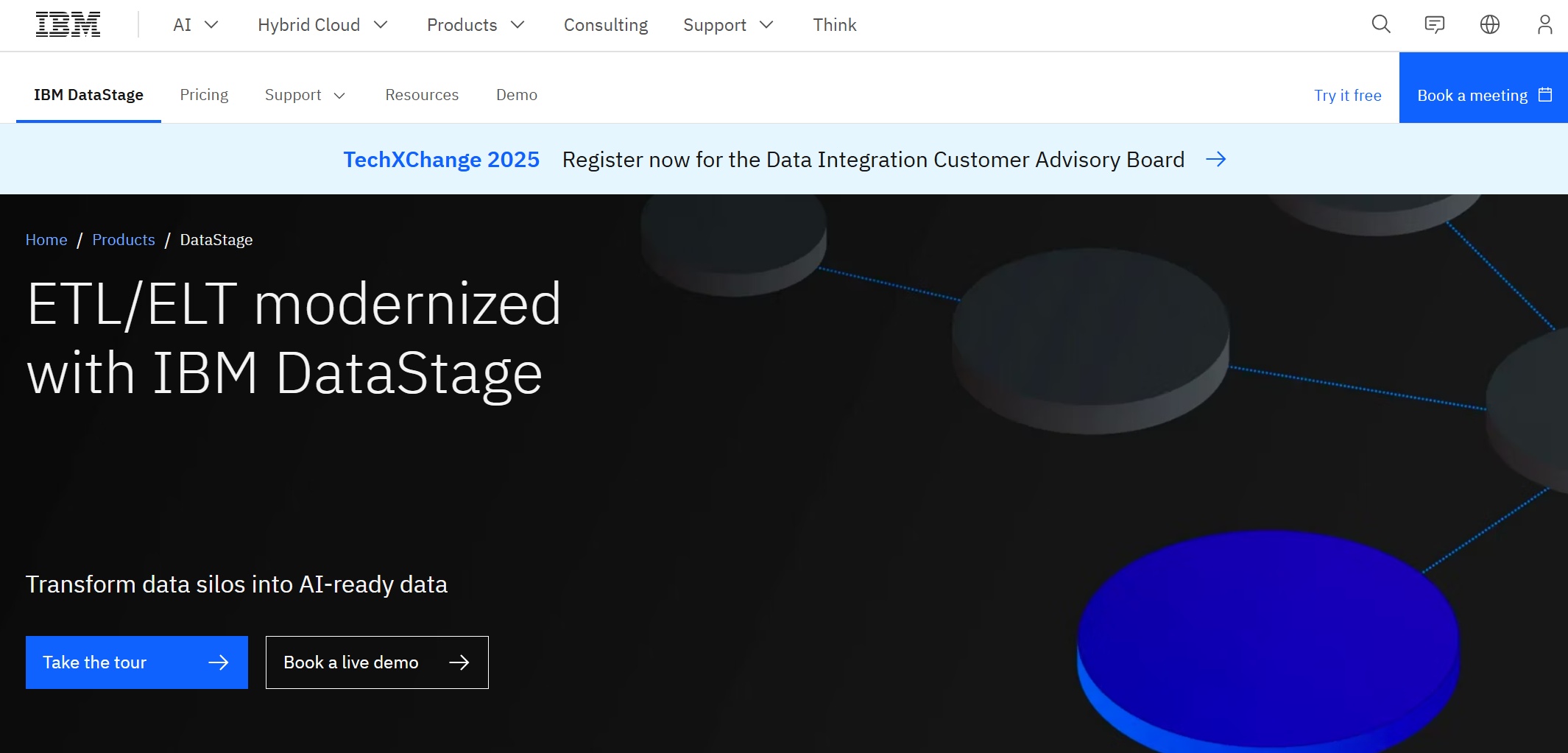
Benefits
You can rely on IBM InfoSphere DataStage to handle complex ETL tools with ease. Its parallel engine ensures high performance, even with large datasets. The automated pipelines and failure detection features save time and reduce operational costs. The platform’s metadata support enhances data governance, helping you meet compliance requirements. Its prebuilt connectors simplify integration with cloud and on-premise systems, making your workflows more efficient.
Ideal Use Cases
IBM InfoSphere DataStage is ideal for enterprises managing large-scale data integration projects. It works well for industries like finance and healthcare that require robust governance and high data quality. The platform is also suitable for organizations looking to automate ETL tools and reduce manual intervention.
Vendor 17: Oracle Data Integrator
Key Features
Oracle Data Integrator (ODI) provides advanced analytics and high-performance ETL tools for seamless data integration. Key features include:
| Feature | Description |
|---|---|
| High-performance transformation | Push-down transformation minimizes performance impact on source systems. |
| Native big data support | Generate Apache Spark code to transform and execute data mappings. |
| Prebuilt connectors | Simplify integration with a large library of knowledge modules. |
| Guided integration | Use ODI Studio to simplify data mapping with best practices. |
| Big data integration | Integrate data from Hadoop, Kafka, Hive, and more. |
| Real-time data warehouse | Load and transform real-time data into a data warehouse or big data system. |
| Governance and transparency | Harvest metadata for data lineage and exploration. |
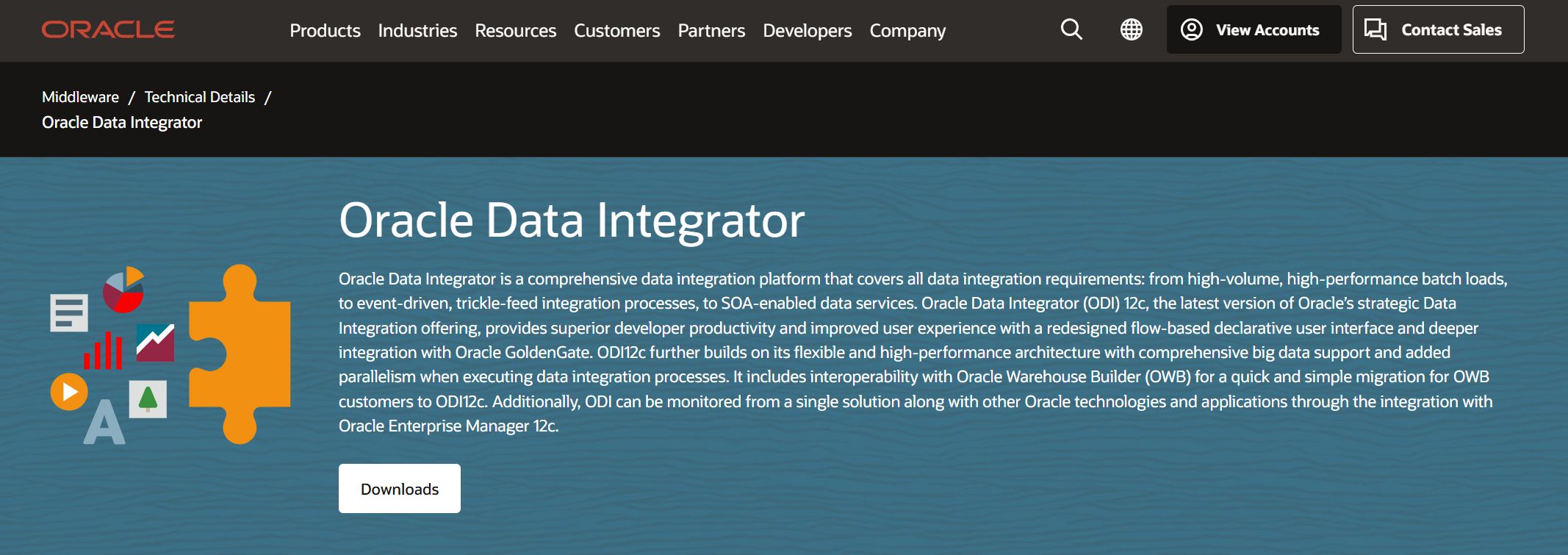
Benefits
ODI’s high-performance transformation capabilities ensure efficient ETL processes. Its native big data support allows you to handle large datasets with ease. The prebuilt connectors and guided integration features simplify complex workflows, saving you time. Real-time data integration ensures you always have access to the latest insights. The platform’s governance tools enhance transparency, giving you confidence in your data.
Ideal Use Cases
Oracle Data Integrator is perfect for businesses managing big data or real-time data warehouses. It works well for organizations needing advanced analytics and robust governance. The platform is particularly effective for industries like retail and telecommunications that rely on real-time insights.
Vendor 18: StitchData
Key Features
StitchData offers a flexible and effortless ETL service tailored for small businesses. It connects to various data sources, enabling you to replicate data quickly and efficiently. The platform’s simplicity and cost-effectiveness make it accessible to teams with limited technical resources. StitchData also allows you to provision data to analysts in minutes, significantly reducing the time spent on data management.
Benefits
StitchData’s ease of use and affordability make it an excellent choice for small businesses. Its flexibility allows you to integrate multiple data sources without extensive technical expertise. The platform’s quick provisioning capabilities save time, enabling you to focus on analysis rather than setup. These features help you manage your budget effectively while accessing powerful ETL tools.
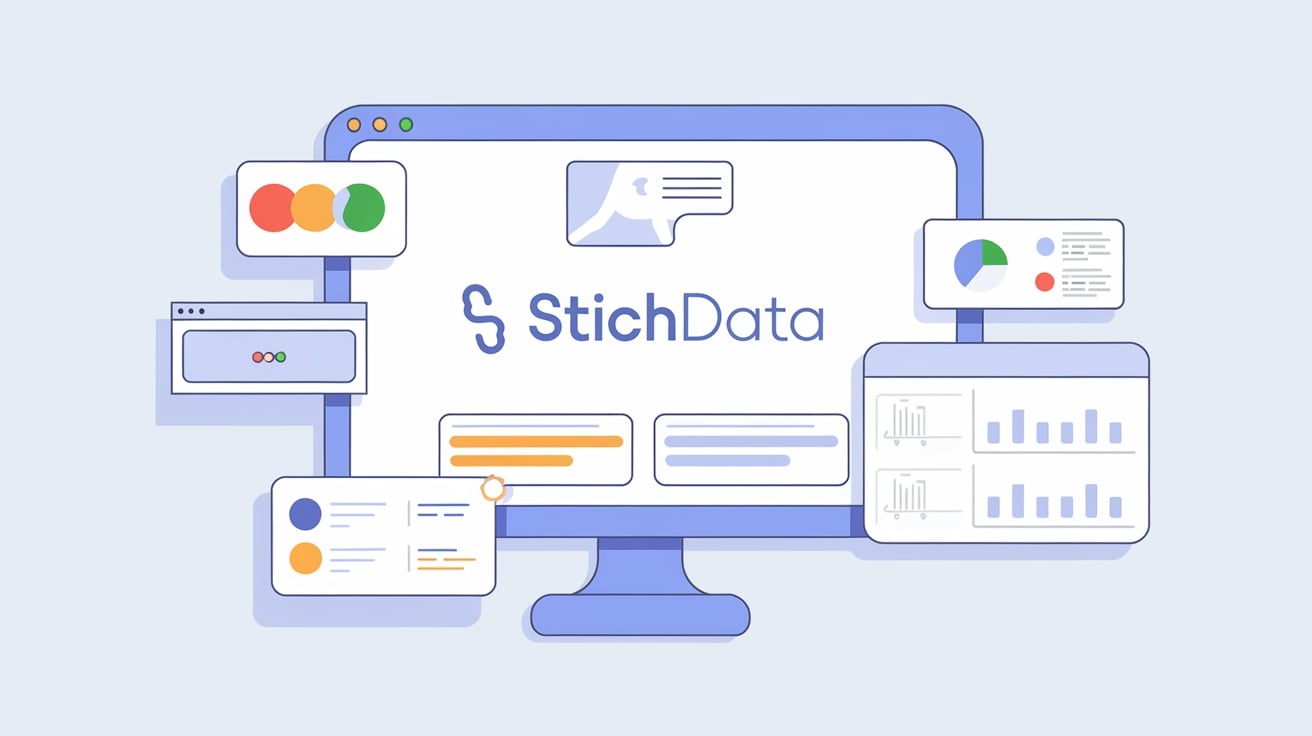
Ideal Use Cases
StitchData is ideal for startups and small businesses seeking a hassle-free data integration solution. It works well for organizations with limited resources that need to connect multiple data sources quickly. The platform is particularly useful for teams looking to streamline data management and improve efficiency.
Vendor 19: Funnel
Key Features
Funnel specializes in marketing data integration, making it a go-to solution for businesses focused on advertising and analytics. It connects with over 500 data sources, including platforms like Google Ads, Facebook, and Shopify. The platform automatically collects, cleans, and organizes your marketing data, ensuring consistency across all channels. Funnel also provides a no-code interface, allowing you to create custom dashboards and reports without technical expertise. Its cloud-based architecture ensures scalability and accessibility from anywhere.
Benefits
Funnel simplifies the process of managing marketing data. By automating data collection and cleaning, it saves you time and reduces errors. The platform’s no-code interface empowers your team to create reports and dashboards without relying on IT support. Its compatibility with a wide range of data sources ensures seamless integration into your existing workflows. Funnel’s cloud-based design allows you to scale your operations as your business grows. These features make it easier to analyze marketing performance and make data-driven decisions.

Ideal Use Cases
Funnel is ideal for businesses that rely heavily on marketing and advertising data. It works well for organizations managing multiple campaigns across various platforms. The platform is particularly useful for marketing teams that need to create custom reports quickly and efficiently. Funnel is also a great choice for businesses seeking to centralize their marketing data for better insights and decision-making.
Vendor 20: Google Cloud Dataflow
Key Features
Google Cloud Dataflow offers a fully managed service for data integration and processing. It supports both batch and streaming data, enabling you to handle diverse workloads efficiently. The platform includes robust monitoring tools, ensuring smooth operations. Dataflow integrates seamlessly with other Google Cloud services, such as BigQuery and Cloud Storage, to enhance your workflows. Its real-time processing capabilities allow you to analyze data as it is generated, providing immediate insights.
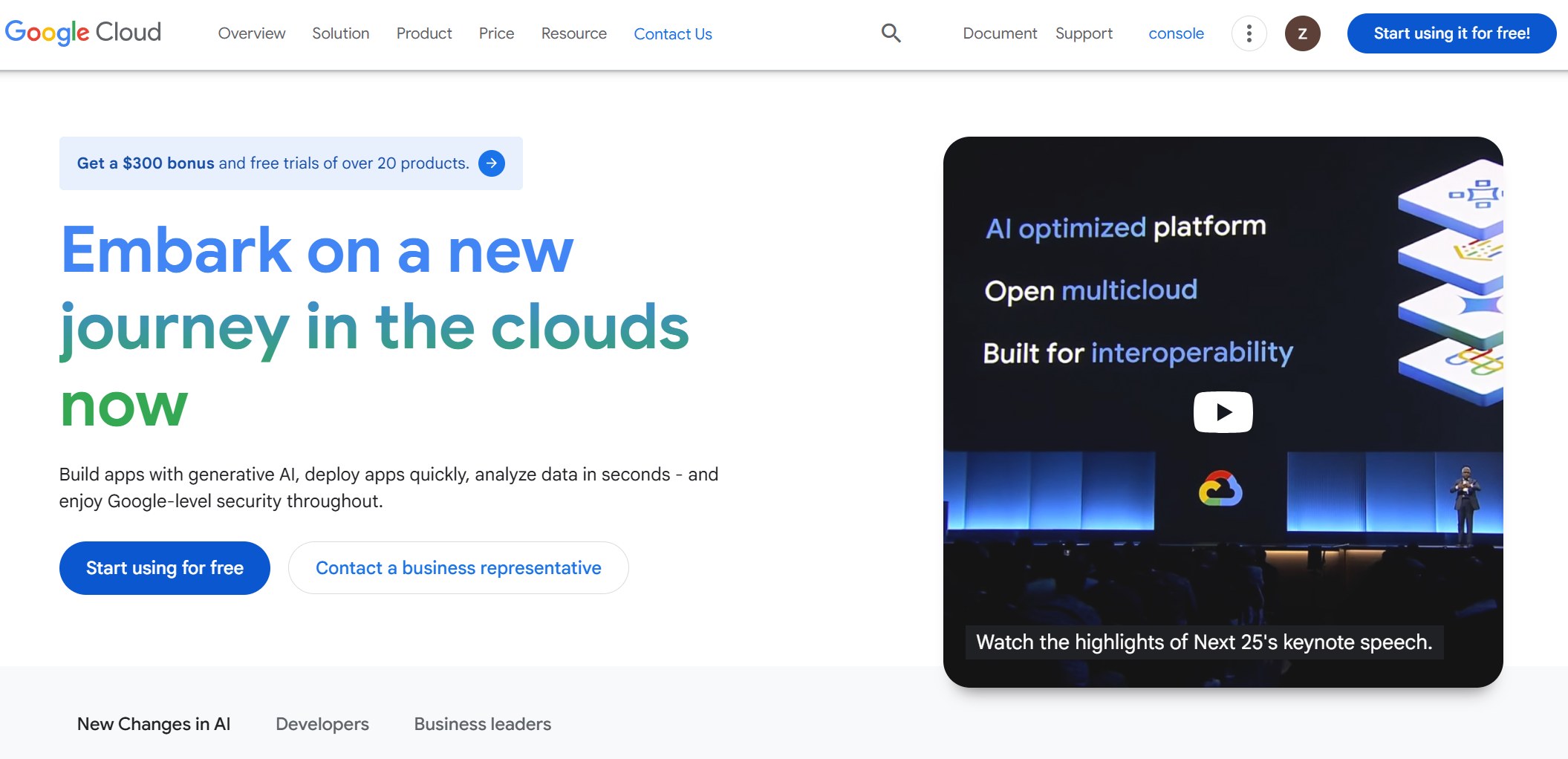
Benefits
Google Cloud Dataflow enables you to process data in real time, which is essential for immediate decision-making. Its ability to handle both batch and streaming data ensures flexibility in managing your workloads. The platform’s integration with Google Cloud services simplifies your workflows and enhances productivity. Dataflow’s managed service reduces the need for additional infrastructure, saving you time and resources. Its robust monitoring tools help you track performance and resolve issues quickly, ensuring reliable operations.

Ideal Use Cases
Google Cloud Dataflow is perfect for businesses that require real-time analytics. It works well for organizations managing large datasets or streaming data. The platform is particularly effective for industries like finance and e-commerce, where timely insights are critical. Dataflow is also a great choice for teams already using Google Cloud services, as it integrates seamlessly into the ecosystem.
Comparison of Leading Data Integration Vendors
Key Metrics for Comparison
When choosing the best data integration vendor, you need to evaluate them based on specific metrics. These metrics help you identify which tools align with your business needs and ensure efficient workflows. Below are the key factors you should consider:
- Ease of Use
A user-friendly interface can save you time and effort. Vendors offering drag-and-drop features or no-code capabilities make it easier for non-technical users to manage workflows. For example, tools like Flowgear and Matillion ETL simplify complex processes with visual interfaces. - Scalability
As your business grows, your data integration needs will expand. Scalable tools like AWS Glue and Google Cloud Dataflow handle increasing data volumes without compromising performance. This ensures your workflows remain efficient over time. - Integration Capabilities
The ability to connect with diverse data sources is crucial. Vendors like Talend and Fivetran provide extensive pre-built connectors, enabling seamless integration with databases, cloud platforms, and SaaS applications. - Performance and Speed
High-performance etl tools process large datasets quickly. Tools like Ab Initio and IBM InfoSphere DataStage use parallel processing to optimize speed and resource utilization. - Cost-Effectiveness
Budget plays a significant role in your decision. Open-source tools like Airbyte offer cost savings, while platforms like StitchData provide transparent pricing models tailored for small businesses. - Security and Compliance
Protecting sensitive data is essential. Vendors like Denodo and Informatica PowerCenter include robust security features and compliance with industry standards. - Real-Time Processing
Real-time data integration is vital for industries like finance and e-commerce. Tools such as Google Cloud Dataflow and Talend provide real-time capabilities, ensuring you always have up-to-date insights.
To further aid your selection process, the following table breaks down critical aspects of each vendor, including user interface ease, scalability capabilities, integration features, and cost efficiency. This comprehensive view facilitates side-by-side evaluations, highlighting distinctions that may sway your decision based on current and future business requirements.
| Metric | Examples of Vendors |
|---|---|
| Ease of Use | Flowgear, Matillion ETL |
| Scalability | AWS Glue, Google Cloud Dataflow |
| Integration Capabilities | Talend, Fivetran |
| Performance and Speed | Ab Initio, IBM InfoSphere DataStage |
| Cost-Effectiveness | Airbyte, StitchData |
| Security and Compliance | Denodo, Informatica PowerCenter |
| Real-Time Processing | Google Cloud Dataflow, Talend |
By focusing on these metrics, you can select the right etl tools to meet your data integration needs. This ensures your workflows remain seamless and your business stays competitive.
How to Select Data Integration Vendors
Assessing Your Business Needs
Business size and data volume
Start by evaluating your organization’s size and the amount of data you manage. Small businesses often benefit from lightweight etl tools like StitchData, which are cost-effective and easy to use. Larger enterprises may require scalable solutions such as AWS Glue or IBM InfoSphere DataStage to handle growing data volumes. Choosing the right tool ensures your data integration processes remain efficient as your business evolves.
Budget considerations
Your budget plays a critical role in selecting data integration tools. Open-source platforms like Airbyte offer cost savings, while fully managed services like Fivetran provide transparent pricing models. Always assess the total cost of ownership, including licensing fees, maintenance, and potential add-ons. Ensure the tool aligns with your financial goals while delivering a positive business case.

Industry-specific requirements
Different industries have unique data integration needs. For example, marketing teams may prefer Funnel for its focus on advertising data, while GIS professionals might choose FME for spatial data workflows. Identify your industry’s specific requirements to select a tool that meets your operational demands.
Evaluating Tool Features
Scalability and flexibility
Scalability ensures your etl tools can grow with your business. Platforms like Google Cloud Dataflow and Talend handle increasing data volumes without compromising performance. Flexibility allows you to adapt workflows to changing needs, making hybrid solutions an excellent choice.
Security and compliance
Data security is non-negotiable. Tools like Denodo and Informatica PowerCenter offer robust security features and compliance with regulations. Look for encryption, role-based access, and metadata management to protect sensitive information.

Integration with existing systems
Ensure the tool supports all your data sources and targets. Vendors like Talend and Flowgear provide extensive pre-built connectors, simplifying integration with databases, SaaS applications, and cloud platforms. A seamless connection reduces setup time and enhances productivity.
Seeking Expert Advice and Reviews
Consulting experts and reading reviews can help you make an informed decision. Look for feedback on ease of use, customer support, and deployment speed. Tools with strong community support, such as Airbyte, often receive continuous updates and improvements. Expert advice ensures you choose a solution that aligns with your technical and operational needs.
Choosing the right data integration tool is essential for creating efficient workflows. These tools simplify complex processes, reduce manual effort, and ensure your data remains accurate and accessible. By leveraging advanced etl tools, you can streamline operations and focus on strategic goals. Data integration also enhances decision-making by providing a unified view of your information.

Explore the vendors listed in this guide to find the best fit for your needs. Each offers unique features to address specific challenges. Start your journey toward seamless workflows and unlock the full potential of your data integration efforts.
Key Takeaways
- Data integration helps fix problems like separate data and mismatched info.
- Picking the right vendor makes work smoother and saves time.
- Cloud tools are flexible and grow with needs, while on-site tools keep data safe.
- Free tools can save money but need tech skills to use.
- Hybrid tools mix cloud and on-site benefits for better results.
Click the banner below to try FineDataLink for free and empower your enterprise to transform data into productivity!
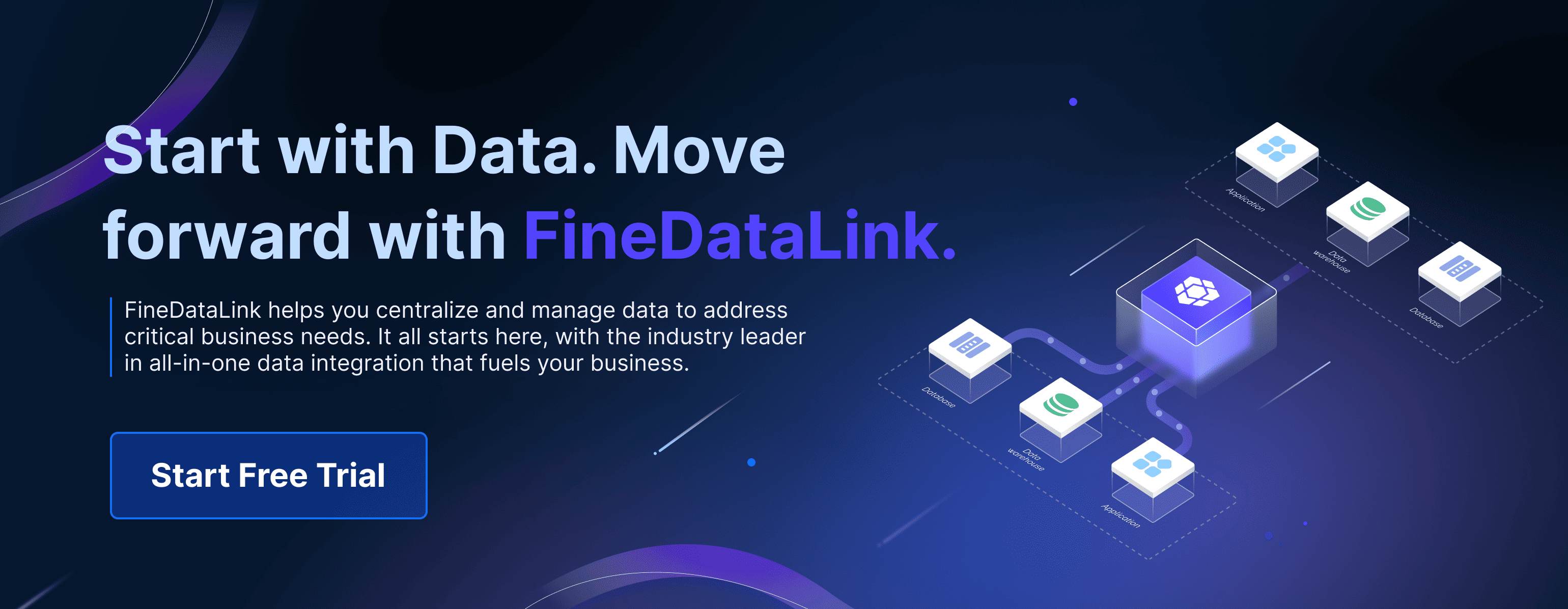
Continue Reading about Data Integration
Essential Data Integration: A Beginner's Guide
Top Data Integration Tools: 2025 Guide
Top 10 Data Integration Software for 2025
What is API Data Integration? API vs Data Integration
Best Data Integration Platforms to Use in 2025
Enterprise Data Integration: A Comprehensive Guide
Top 7 Data Integration Patterns for Modern Enterprises
FAQ

The Author
Howard
Data Management Engineer & Data Research Expert at FanRuan
Related Articles

10 Best Data Orchestration Tools for 2025 You Should Know
Compare the best data orchestration tools for 2025 to streamline workflows, boost automation, and improve data integration for your business.
Howard
Nov 28, 2025

10 Best Enterprise ETL Tools for Data Integration
Compare the 10 best enterprise ETL tools for data integration in 2025 to streamline workflows, boost analytics, and support scalable business growth.
Howard
Oct 02, 2025

What is Real Time Data Integration and Why It Matters
Real time data integration connects systems for instant, accurate data access, enabling faster decisions, improved efficiency, and better customer experiences.
Howard
Sep 24, 2025



